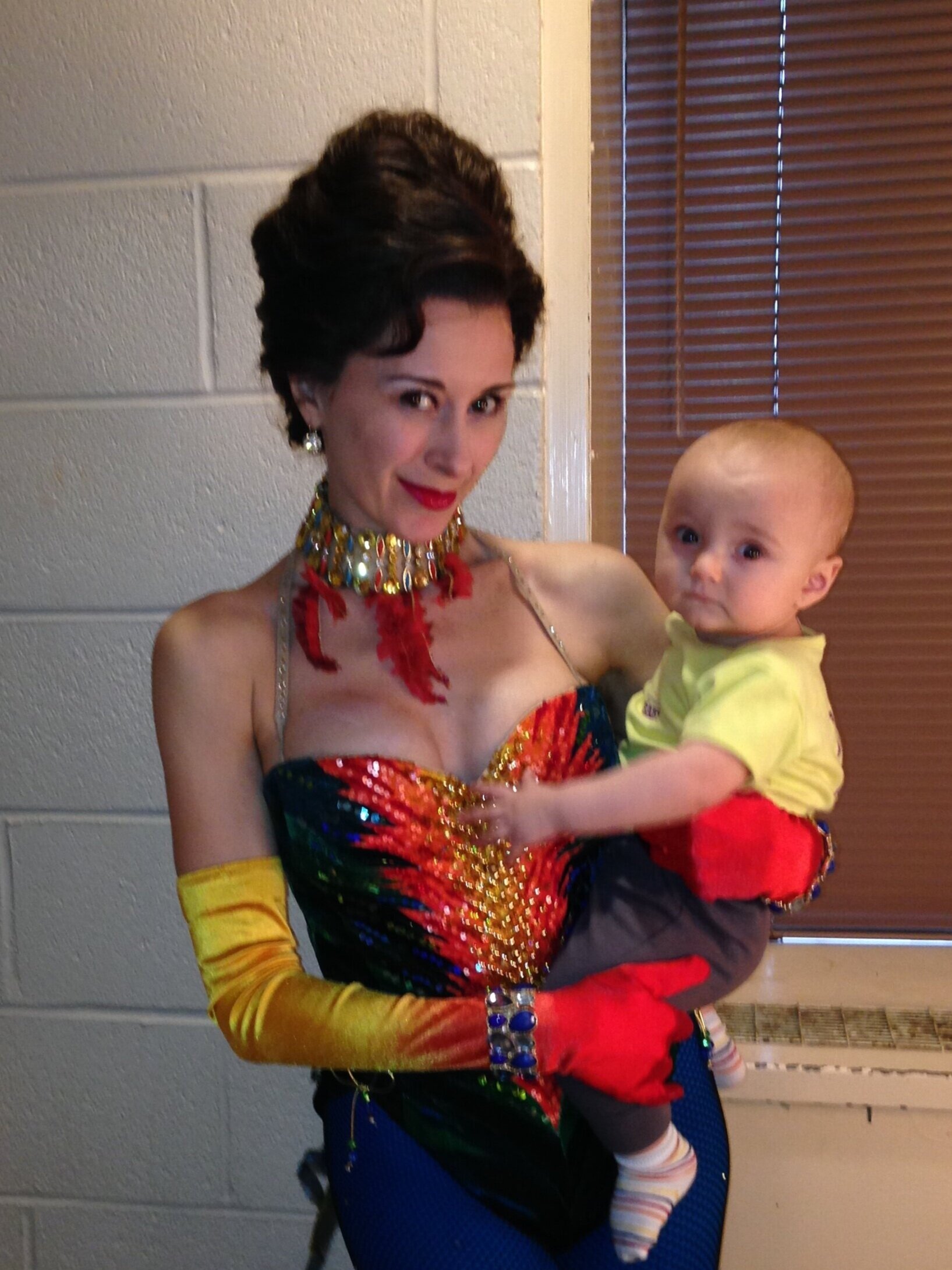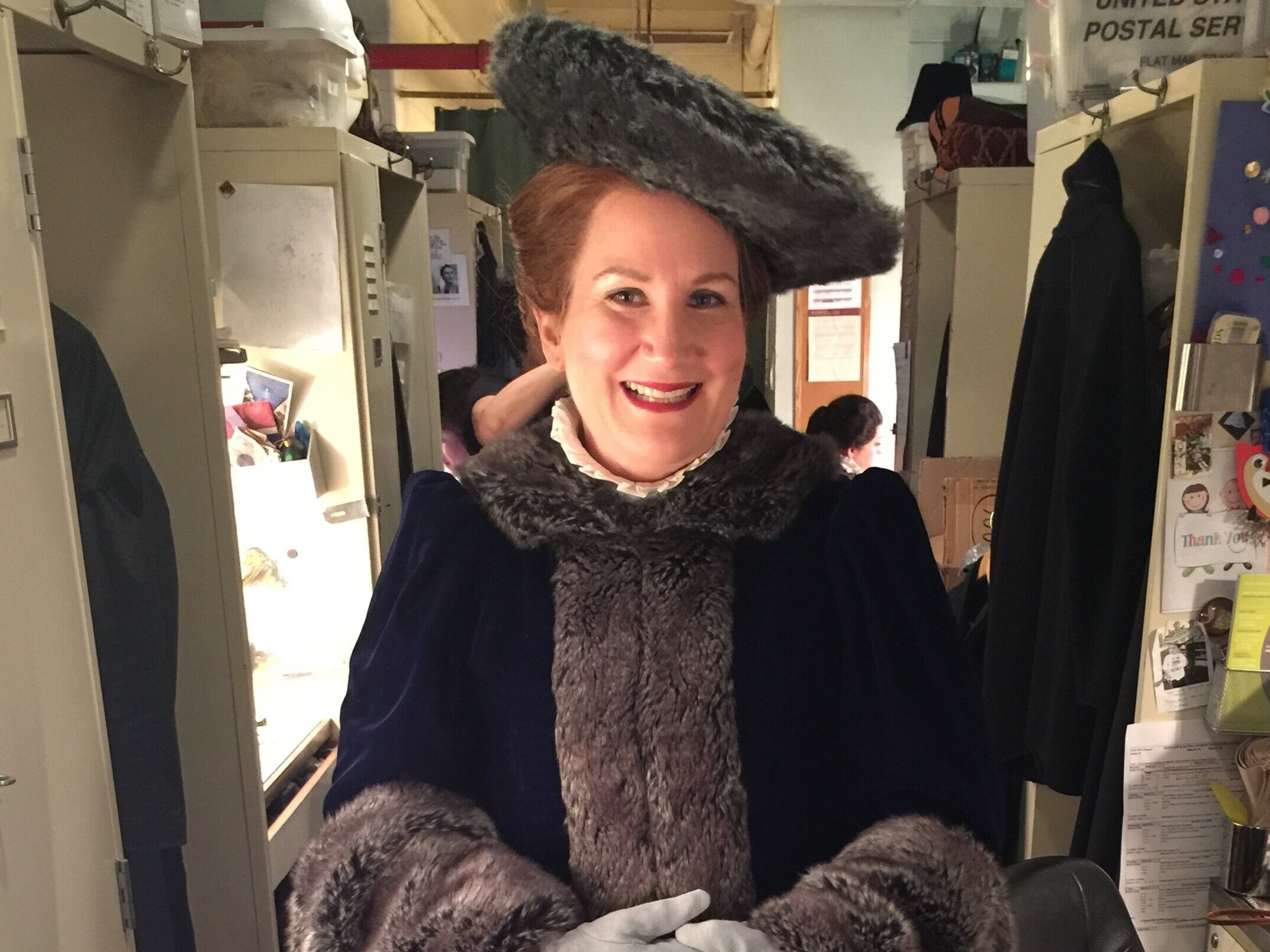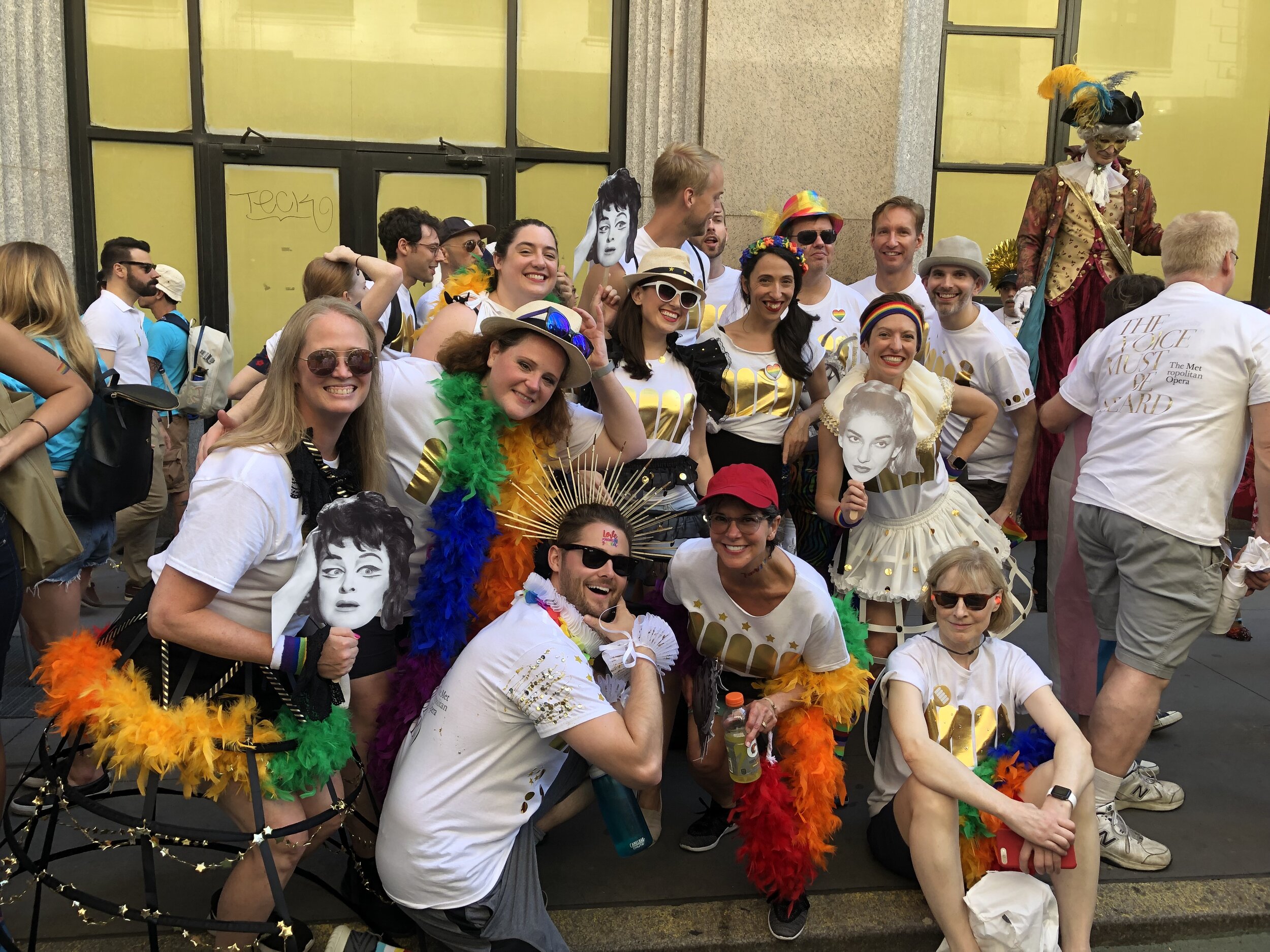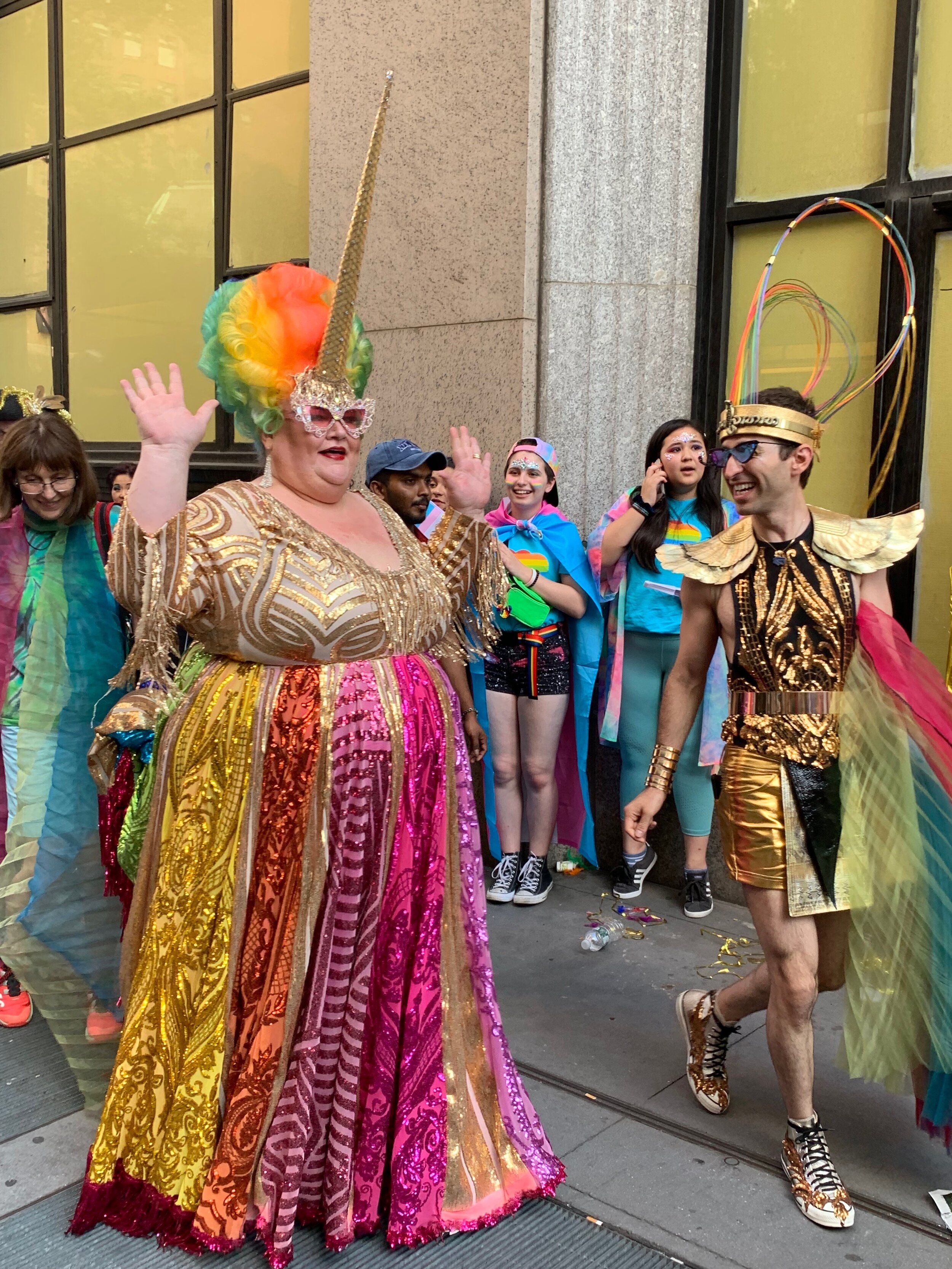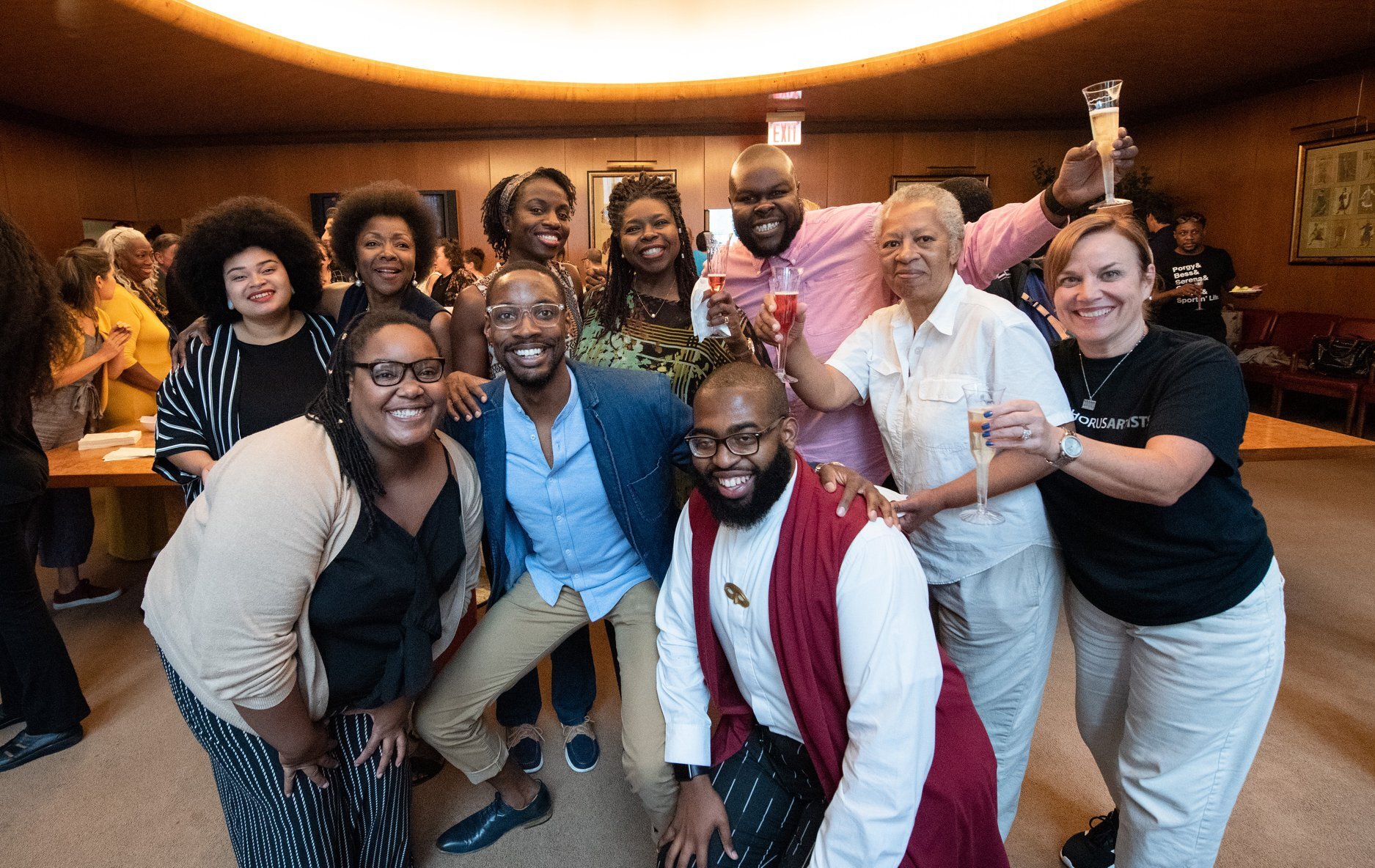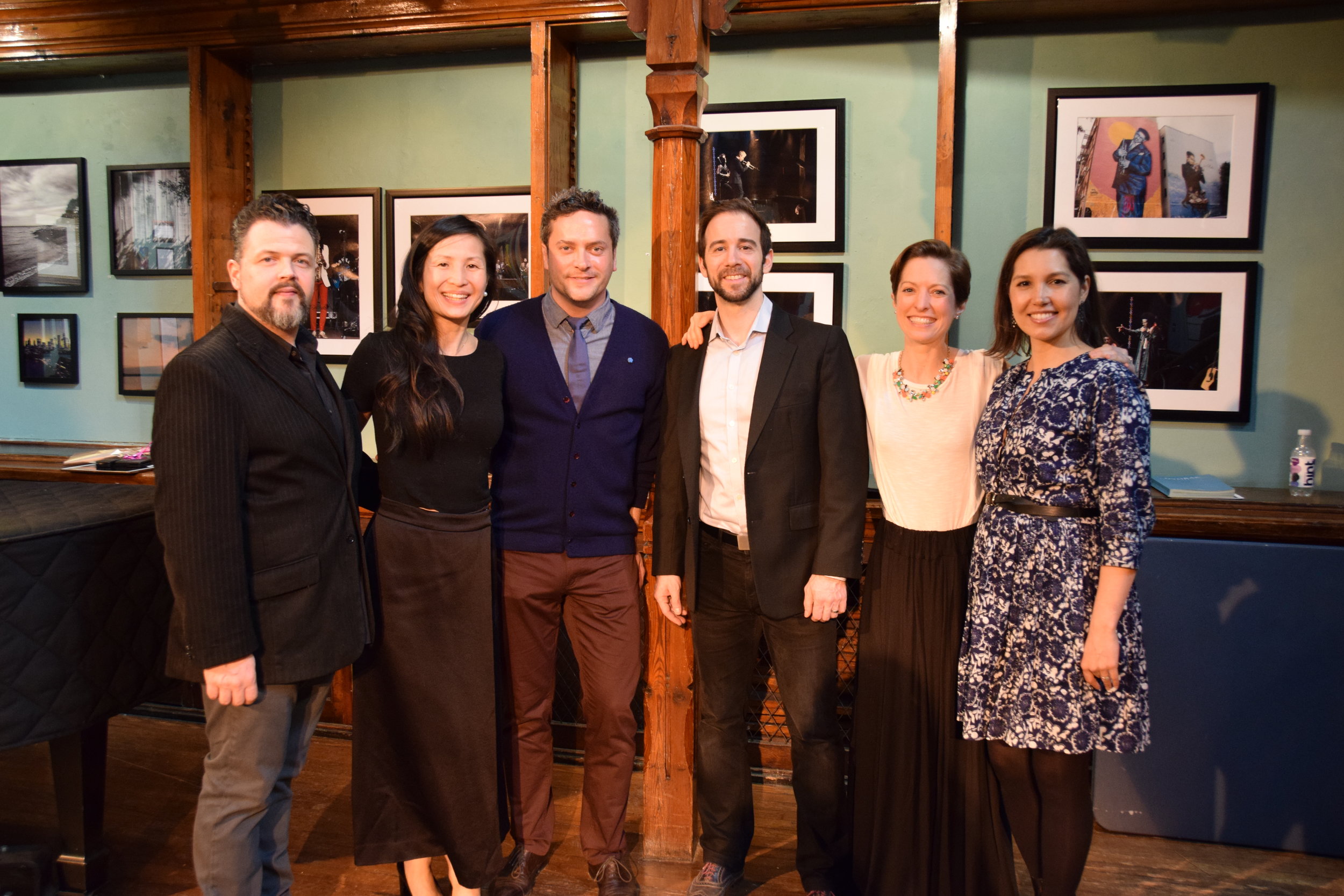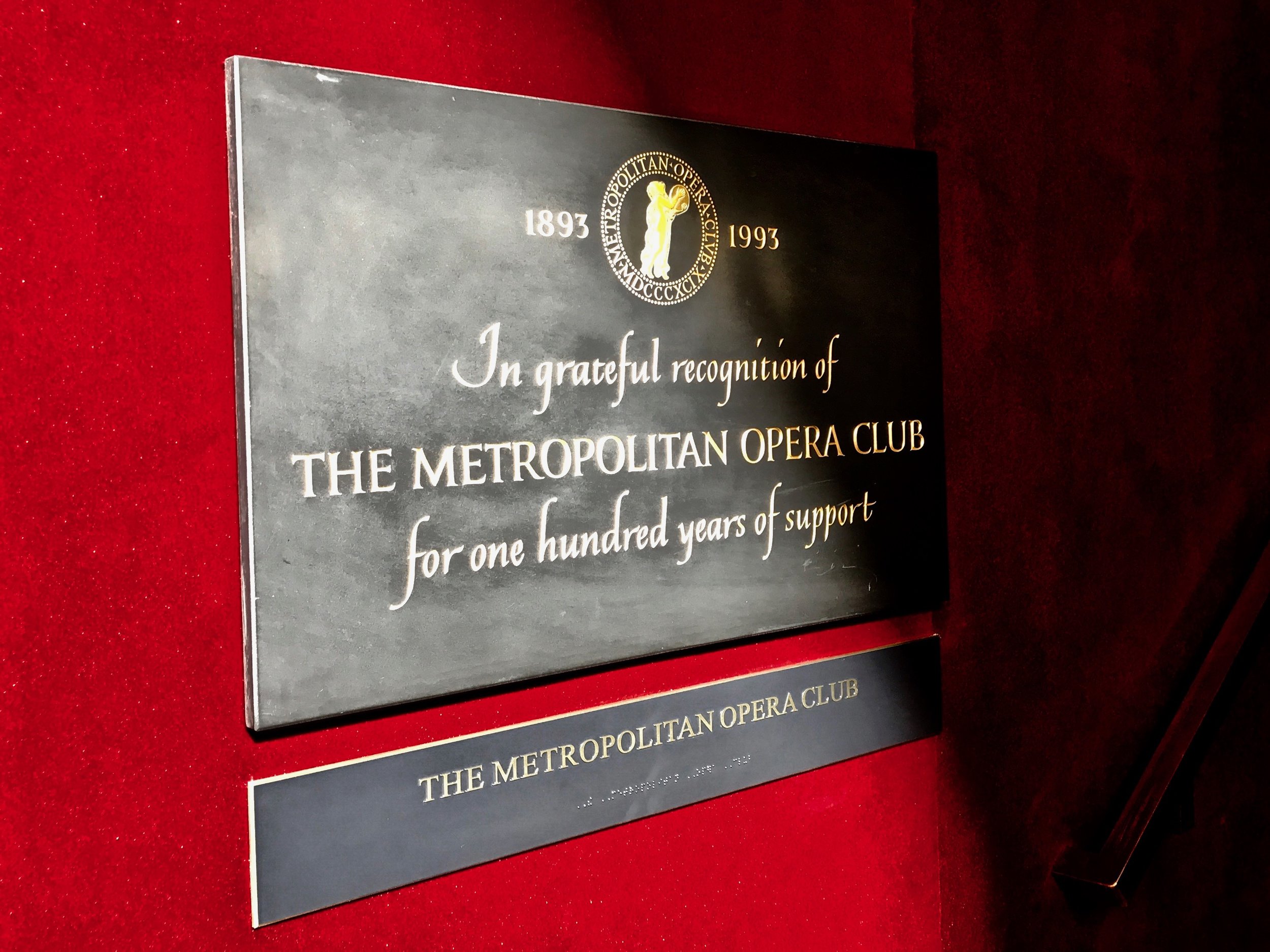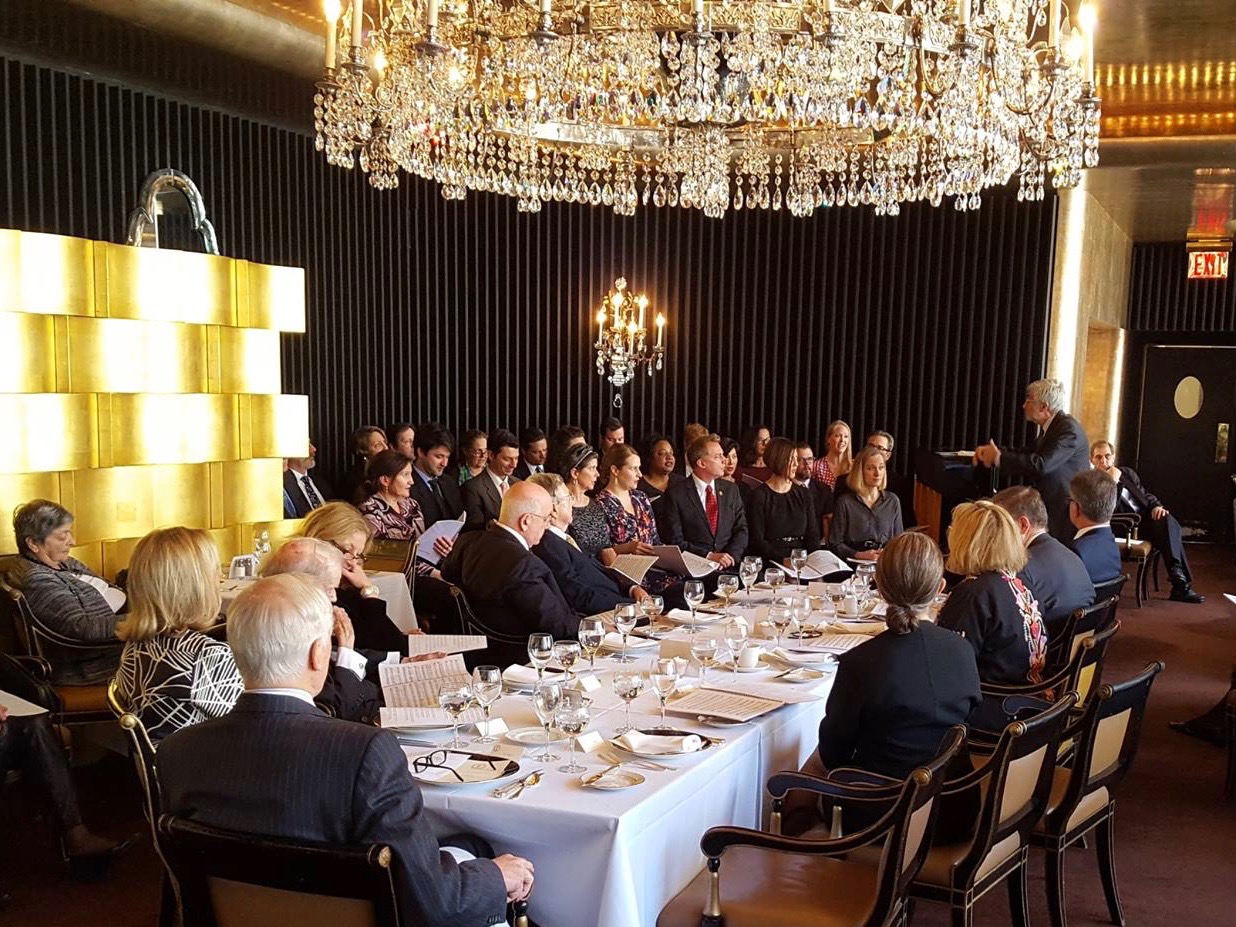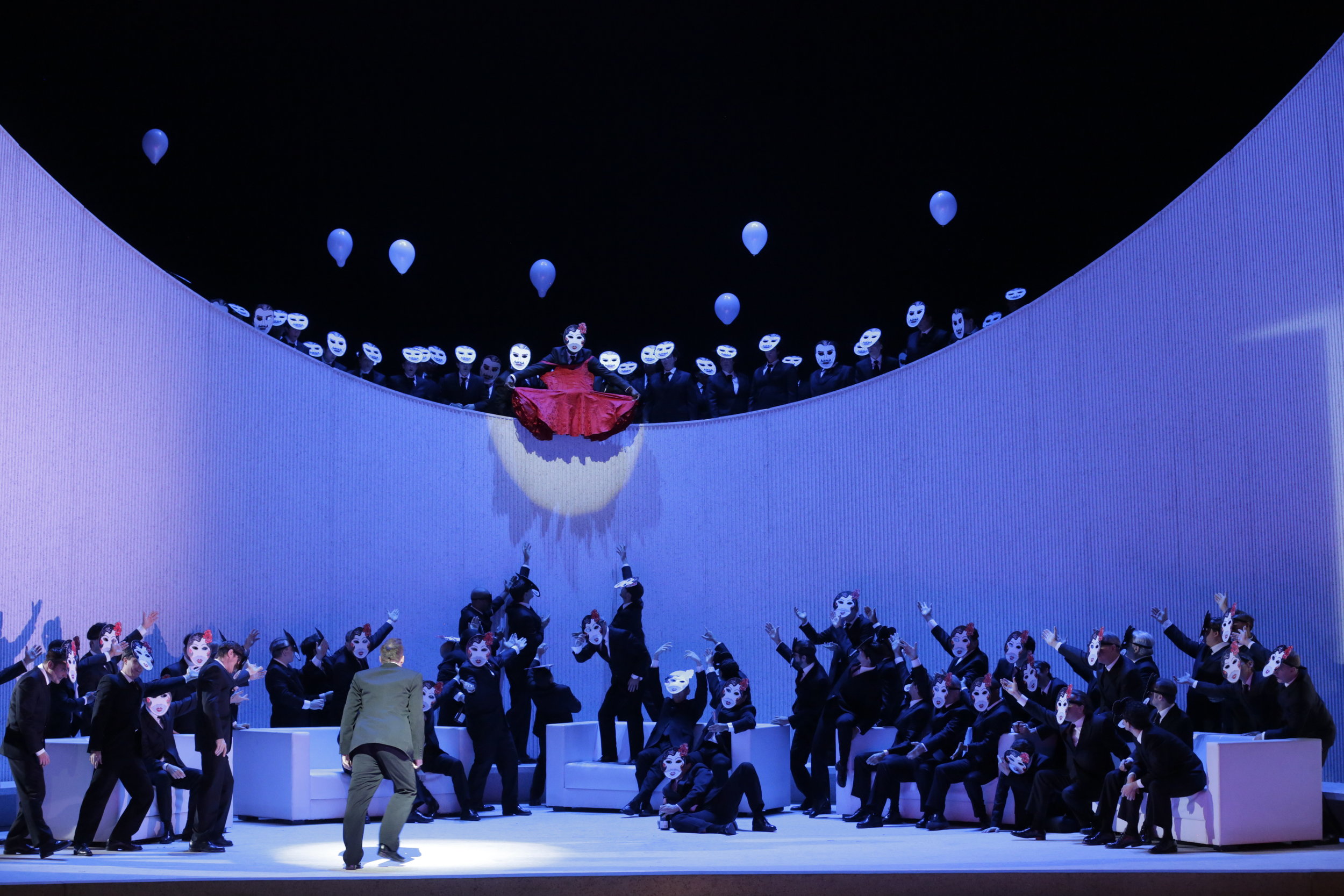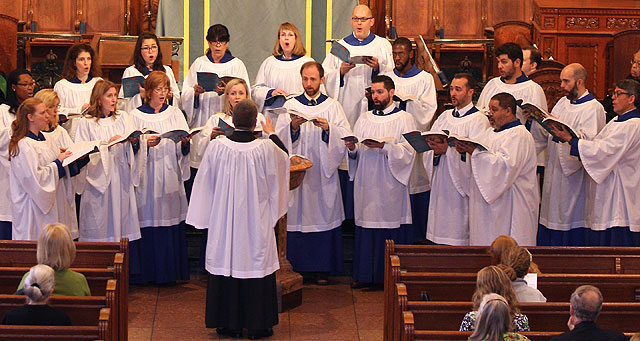Meet The Dancers: Michelle Vargo
In this edition of Meet The Dancers, we introduce you to Michelle Vargo, a talented dancer who has been an important part of the Metropolitan Opera's productions for the past 22 years. "I never imagined I'd have such a long career here", Vargo said. But we're so glad she has!
In our previous Met Artists Newsletter, we debuted our “Meet the Dancers” column, so you could get to know some of our exceptionally talented colleagues whose contributions elevate the operatic art form in truly memorable ways. In this edition, we meet the amazing Michelle Vargo, who has been gracing the stage of the Metropolitan Opera for 22 years!
How long have you been dancing at the Metropolitan Opera?
This year is my 22nd season with the company. My 20th season, I celebrated dancing all season with a growing baby in my belly. It's really amazing. I never imagined that I'd have such a long career here.
What was your training?
I grew up in Butler, PA where I studied at a small dance studio (Lee's School of Dance). My teacher was very strict. We took Ceccetti ballet exams every year, but also studied jazz, tap and acrobatics. I'm very thankful that I studied multiple disciplines before moving to New York City and attending the Juilliard School. At Juilliard, I honed those skills and started to get more of an idea of where I'd fit in in the dance world.
What does a typical day at the Met look like for you?
It really depends on the season and which operas are happening. For example, this season, September and October were intensely busy, rehearsing and performing three shows at the same time. So, a typical day this September was often rehearsing from 12:00pm-5:00pm. In October, I had fewer rehearsals, but a very busy performance schedule.
What are your favorite operas/opera roles and why?
I'd say my top three operas have been Parsifal, Damnation of Faust, andSamson et Dalila (the Elijah Moshinsky production, which premiered in 1998). Parsifal was such a once-in-a-lifetime creative, unique experience being immersed and moving through a stage filled with bloody water. Damnation was intensely physical. It was a very daredevil production as we threw our bodies over the balconies and jumped through trap doors. It was a very rewarding and thrilling experience every time I performed it. I must admit, I was nervous for every show unlike any other show I've performed at the Met. Samson was my first new production. It was the beginning of bringing more contemporary choreography to the Met, it was part of my first Japan tour, and it was also the beginning of my Met career, so it holds a sentimental place for me. Another very memorable performance was going on as the solo bird in The Magic Flute the week I found out I was pregnant with my second child. There are many more I love. I could go on and on.
How many hours a day do you dance?
That varies depending on how much rehearsal/shows I have that day. I could have a day where I rehearse two or three shows until 5pm and have a show at night, or have an off day from working but still take class or do my own workout. I almost never take a day off from working out, dancing or doing yoga.
How has your experience at the Met changed (or stayed the same) over the years?
I started quite young as an extra dancer, and was very quickly added to more shows every year. It took a while to be hired into the company full-time, and that both did and didn't change my experience at the Met. I'd already been cast in many shows, but it meant a full-time commitment and availability to the Met, as well as the added benefits and weekly salary.
What about the job changed when the Met disbanded the Corps de Ballet?
While I do miss the salary and benefits, there is more freedom in being a freelancer. My commitment to the work is the same.
How do you balance your work life with your family life?
It's not easy, but it has become easier. I have a 7-year-old daughter and a 17-month-old son. They are my world. I jumped back into classes and rehearsals very quickly after the births of both children, which was the most difficult time. But now, I think having the balance of being both mama and dancer makes me better at both roles. I don't take anything for granted anymore and really enjoy and savor being in the present moment more than ever.
Where else do you dance besides the Met Opera?
I've danced with many outside companies over the years. Currently I'm in the studio with Christopher Caines making new material for an upcoming show. I've also worked on my own choreography and was a touring singer/songwriter for many years before the kids were born.
What do you do for self-care/recovery after a long day (or week) of dancing?
Before having children, it was easier to fit regular body work into my schedule. My daily self-care now includes meditation and gentle yoga with breath work to realign my body, rolling out with tennis balls and rollers and taking an epsom salts bath. When I can or am in desperate need, I see a kinesiologist, acupuncturist or a reflexologist, depending on my needs at the moment.
Editor’s Note: The majority of this article was already written when the COVID-19 pandemic swept the country and forced the temporary closure of all performing arts organizations in New York City, including the Metropolitan Opera. I asked Michelle how she was feeling after the season was canceled.
Losing all of my work through the end of the season feels pretty overwhelming, but I’m trying to stay positive and teach some virtual yoga classes. It’s also heartbreaking that my daughter Ella was about to have her debut at The Met in Werther with me. I lost all my work in one day, and then had to give her the bad news. It was a pretty rough day. She now makes both of us put on a show in the living room every evening that was supposed to be a Werther performance. ️
If you have the ability to donate to help out-of-work performing artists affected by the COVID-19 closures, or if you yourself are an out-of-work artist looking for financial assistance, please check out this link and this link. Both have fairly comprehensive lists of organizations providing need-based grants to eligible individuals during this economically challenging time. Thank you for your consideration!
Recipe Corner: Mary Hughes Brings Us Some Much-Needed Levity
Yes, we realize that this looks, rather disturbingly, like a kitty litter box that desperately needs a spring cleaning. But would you believe us if we said that all of the ingredients in Mary Hughes' Kitty Litter Cake were not only edible, but actually delicious?
Gentle Readers, we can all agree that the past month or so has been stressful. Between the fear of contracting the Coronavirus and the possibly greater fear of the inconvenience of a large-scale quarantine, New Yorkers (and the rest of the country, of course) have been doomsday-prepping like champs and stockpiling plenty of non-perishable food staples.
Thankfully, Met chorus mezzo-soprano Mary Hughes has an irreverent antidote for the Coronavirus doldrums that fits neatly into your shelf-stable apocalypse meal-planning.
Have you ever heard of a Kitty Litter Cake?
No? Well…now you have, and as disgusting as it sounds (and, honestly, looks), the end result is delicious, and the ingredients are all things you can stock away in your bomb shelter with the 75 containers of Clorox Wipes you bought at Duane Reade.
Mary says this of her delicious scatological creation: “I made this with my 9-year-old and it was fun and we laughed, even though it is gross. I've made it for bake sales (people actually buy it), and it’s perfect if you need a quick dessert option.”
Name: Mary Kristine Hughes.
Hometown: Longmont, Colorado.
Years at the Met: I’m about to finish up my 14th season!
My favorite opera is: Falstaff or Madama Butterfly.
One of my most memorable experiences at the Met so far is: ONSTAGE: Being on stage with Ewa Podles when she sang Voce di donna in La Gioconda; OFFSTAGE: flying alone with my 5-month old to Japan for our last tour.
Other than opera, my favorite type of music is: Nueva Cancion from South America.
When I’m not at the Met, you can find me: Taking meeting minutes for the PTA.
The most outrageous thing I've ever cooked (or eaten) was: I’m not much of a cook, but I’m married to one, and he makes incredible chicken mole out of the pulverized, smoked skins of more than a dozen different types of chilis from the mountainous region of Puebla, Mexico.
The three things in my kitchen I can’t live without are: My Vita Mix, wooden spoons, and my favorite coffee cup.
Currently, my three go-to ingredients are: frozen mangos, fresh limes, and Alacran tequila.
If I had to choose, my “last meal” would be: Tacos al carbon with fresh salsa, and an ice-cold Coke out of bottle.
Kitty Litter Cake
Ingredients:
1 boxed yellow cake mix (any kind)
1 boxed spiced cake mix (something in-between white and chocolate)
1 box of instant vanilla pudding
1 package of golden oreos
Blue and green food coloring
1 small bag of Tootsie Rolls
Approximately 10 fun-size chocolate bars
Various chocolate-covered candies (I used dark chocolate caramels for variation.)
Plastic cat box and scooper for serving (NB: Obviously, use a NEW one, and wash well with soap and water.)
Instructions
1. Prepare the cakes per the instructions on the box.
2. While the cakes are baking, prepare the instant pudding and refrigerate.
3. After the cakes are finished and cooling, prepare the 'clumping' litter by putting the oreos through the food processor with several drops of green and blue food coloring and set aside. It should be a powdery, sandy consistency.
4. When the cakes are cooled, crumble up into a large mixing bowl and add the chilled vanilla pudding to form a pasty dough.
5. Spread the cake mixture along the bottom of the CLEAN litter pan, then sprinkle the clumping mixture over the top. Layer between the cake and clumping mixture as you would a lasagna. Toward the top layers, start adding molded chocolate that looks like, well, cat poop. It helps if the chocolate is slightly warm so that it can be shaped into little turds. (Yes, you read that right. Mary said “little turds”. See the picture for inspiration.)
(Editor’s Note: If you can not stomach the idea of serving a dessert in an actual kitty litter box, I think Mary would agree that a large casserole dish would work just as well. Bon appetit, friends!)
Alumni Corner: The Importance Of Staying Connected
Carolyn Sielski was a member of the Met Chorus for 21 years, but that didn't stop her from staying connected to her beloved former colleagues after she retired.
by Brandon Mayberry and Carolyn Sielski
While many of us have social media to stay connected to the outside world, we shouldn’t forget that not everyone has that outlet during this rapidly changing landscape, where real life social distancing is the name of the game. Senior citizens in assisted care facilities/nursing homes, or isolated at home without families to care for them, are most vulnerable to the effects of this extreme social isolation. While we attempt to protect this vulnerable age group from contracting this deadly virus, we shouldn’t lose sight of the emotional toll this isolation can take in the meantime.
In the spirit of connection in all its many-splendored forms, allow me to introduce Met Chorus Alumna and current Met Opera Chorus Retiree Coordinator Carolyn Sielski. Carolyn has been brilliantly facilitating that connection for the last 11 years among the 60 retired choristers.
Here’s a look into Carolyn’s history as chorister at the Met, and the role she now plays as the Met Chorus Retiree Coordinator, in her own words.
When I was hired in June 1986 by David Stivender, I had already been married 18 years and was busy raising 2 teenage daughters. I had taught public school music, was a member of the New York City Opera, had a church job, toured in 2 national opera company tours, and was playing violin in a semi-professional orchestra.
Life changed after that successful audition one afternoon, where David described every opera for which I would be responsible and have memorized for the first chorus rehearsal in August! I was presented with a huge stack of music from John Grande, the Met librarian. Then I was taken to the costume department for measurements. I could barely find my way around the corridors of the building! The entire summer I spent collecting recordings, making tapes, and studying operas. Something that has always stayed with me was the musty smell of the old scores, browned with age and stained with coffee cup rings and pencil markings from choristers before me. I knew that I was in possession of sacred and historical treasures.
Highlights of my 21 year career at the Met are numerous, but I’ll enjoy mentioning a few.
My first solo as the Page in Rigoletto was a thrill for me, anticipating the beat while singing in the upstage tower. I remember my beautiful costume with the previous pages’ name label sewn on the inside of the costume. Although I had my own dressing room in the principal artists area, nobody would dress me because I was just a chorister! My husband happily dressed me that night.
Another highlight was being selected to sing one of the nuns in Dialogues of the Carmelites! Being part of that history inspired my husband and I travel to the Cimetiere de Picpus in Paris and retrace the history and remains of the nuns.
It was a highlight to work with the great artists of the Golden era: Domingo, Pavarotti, Milnes, Peters, and Sutherland, to name a few. Also, it was a joy to perform in Zeffirelli’s glamorous productions of La Bohème, Carmen, Turandot , Tosca, Cav/Pag, Otello, Don Giovanni, La Traviata, and Falstaff. (Editor’s Note: Only Zefferelli’s Turandot and La Bohème remain in the current repertoire at the Met.) They all contained beautiful and realistic sets, with costumes Zeffirelli designed himself. He once took the time to give each chorister a personalized, autographed sketch of an act of one of his operas. (I have mine framed on the wall in my living room.)
When I retired in 2007 after 21 years, there was a transition for me. It’s that ego thing that’s created when you realize that you had the best chorus job anywhere, but it’s not who you are anymore. But I do love being retired now, traveling to Europe with my husband and trying to stay connected with old friends, other Met retirees and my family. I don’t miss the daily commute by car from New Jersey into New York City. But I’m busy on my own terms.
As retiree coordinator, I want to keep the retiree traditions alive, which were originated by [former Met choristers] Elinor Harper and Elyssa Lindner. There has always been a party given every few years for the newest batch of retirees, sponsored by the regular chorus. The party is usually a first-class send-off at the Met with speeches, food, plaques, special souvenir photo albums, and an “In Memorium” recognizing retired choristers who have passed on. It’s a reunion event that all the retirees look forward to.
The Retiree Coordinator’s responsibilities have increased since I have taken over. I create an updated retiree directory each year with emails, addresses and phone numbers, and a newsletter which highlights retiree news. The retirees give a voluntary donation which covers expenses for the directory and postage. When a retiree dies, we use some of the funds to send flowers to the funeral or donate to a charity or organization in their memory. This way, we always remember our Met family.
Statement On The Met Season Cancellation
The Met Opera Chorus is deeply saddened by the news of the cancellation of the remainder of the 2019-2020 Metropolitan Opera season. You can read our statement here.
The Met Opera Chorus is deeply saddened by the news of the cancellation of the remainder of the Metropolitan Opera 2019-20 Season. This is a difficult time for the company and everyone who works so hard to make magic on our stage over 200 times a year. We will persevere and overcome this challenge and remain a chorus united, even in the face of unprecedented adversity.
We echo our union, the American Guild of Musical Artists (AGMA), who represent chorus, soloists, dancers, stage managers, stage directors, and actors, in a call for emergency relief for all artists affected by the current crisis.
"While we appreciate what the Met has done to assist artists after bargaining with AGMA, like keeping health insurance going for certain artists who receive their health insurance through the Met, it's simply not enough during this pandemic. Our artists are facing a scary and uncertain future; they depend on performance and rehearsal fees to survive and they are out of work indefinitely. Many do not qualify for unemployment, many will lose health coverage, and many are not sure how they will continue to pay their bills. To that end, AGMA is lobbying for federal, state, and local emergency relief. We are depending on our signatory companies, including the Met, to support our artists and to help amplify our message that our artists need COVID-19 coverage and emergency benefits."
La Damnation de Faust: A Chorister's Synopsis
Hector Berlioz called La Damnation de Faust a "dramatic legend,”", not an opera or an oratorio. However you define it, the piece is a tour-de-force for the chorus. Tenor Daniel Clark Smith gives us an idea of how we express the text and story line without sets or costumes.
In the Met’s concert production of Berlioz’s La Damnation de Faust, the chorus is tasked with expressing the complex emotions of various characters without sets, costumes, or makeup, while holding scores in the traditional style of an oratorio. To give you an idea of what to expect from the performance, tenor Daniel Clark Smith gives us a chorister’s perspective of the first half of the piece.
Hector Berlioz called La Damnation de Faust a "dramatic legend", not an opera or an oratorio. Regardless of how you define it, the piece is a tour-de-force for the chorus. When performed as a concert piece, as we do this season at the Metropolitan Opera, the cast and orchestra must bring the drama to life without the help of costumes, set pieces, and props. Just as our four principal singers must sing with boundless expression, the Met Opera Chorus (at nearly 100 singers) depicts characters both natural and supernatural with only their voices. The chorus parts require a myriad of vocal colors, diction, and dynamics to realize characters from devils to angels, and everything in between.
The opera begins with Faust singing of the arrival of Spring, which awakens memories of his youth. The chorus' first appearance, the Peasants' Dance, uses the bright vowels of our "tra la la" chorus to mock Faust's age, as our accented laughing figures whirl around him. Dancing, the shepherdesses' flirt with their dresses, which leads to the tenors' third verse - a dialogue between amorous peasants. Tra la la, indeed!
The piece continues with the Hungarian March played magnificently by the Met Orchestra, an often excerpted concert piece of its own. Passing armies leave Faust alone in despair when our Easter Hymn raises his spirits and reminds him of his faith. For the chorus, the Easter Hymn is full of gorgeous, long melody lines, sung with clear diction and lightness of tone. The harmonies swell like those of a grand organ, bringing the opera house to church. Only the harmony of the final Hosannas hint at a sense of foreboding for Faust.
And with that sudden shudder to a minor key, Méphistophélès is introduced. The demon convinces Faust that he has all the answers, and we are swept into a tavern in Leipzig: "A boire encor!" - "Another drink!" The next sequence of choruses begins with the robust, virile energy of a tavern featuring rhythmic four-part men's music -- a full-throated Barbershop sound with liquor added. When we've finished our celebration of being in a smoky wine-filled tavern, we call out for a funny story -- Brander the Bartender has one to tell, if he's not too drunk to remember it! It's the Song of the Rat who has found himself cooked. The scene devolves into a drunken, slurred "Amen" fugue, replete with exaggerated vocal glissandos and, at times, annoying repetition. The piece seems to be the composer's way of mocking the musical form itself, and for us, it's a drunken Requiem for that poor rat. Following this ode is the Song of the Flea, this time sung by Méphistophélès. The Orchestra has all the "flea" action in this one, with string lines that buzz and scratch, and the Chorus joins in with laughter and "Bravos". Sharp accents in our last line depict the demise of the flea: "Écrasons-la soudain!" - "Let's squash it immediately!"
One of the most beautiful choruses we sing this season defies staging: the Chorus of the Gnomes and Sylphs. There is nothing better than one's own imagination and Berlioz' ingenious orchestration to portray the scene. Méphistophélès takes the audience and Faust out of Leipzig to the banks of the Elbe River, where we immediately feel the trees around us. A beautiful clarinet solo melts into a bassoon line, and we sense the lush greenery and the magic of the imaginary spirits Méphistophélès calls forth. We are the gnomes and sylphs, singing gossamer lines that ebb and flow with the wind. Long vocal lines are balanced with whispers of text throughout the piece, adding texture to the woodland setting. Faust dreams of a girl walking through the woods, and when we climb out of the texture to say "Elle t'aimera!" - "She will love you!", Faust calls out for Marguerite. This sets up the rest of the drama: Méphistophélès promises to lead Faust to his love.
These varied and extreme vocal colors keep us busy throughout the performance, and hopefully give the audience much fodder for their imagination. This season's four performances of La Damnation de Faust not only provide us with the opportunity to listen to the peerless Met Orchestra (led by Maestro Edward Gardner) and this phenomenal quartet of soloists (Elīna Garanča, Bryan Hymel & Michael Spyres, Ildar Abdrazakov, and Patrick Carfizzi) but they are an opportunity for the Chorus to show our strengths in acting with our voices.
Ned Hanlon vs. The Great Met Opera Bake-Off
Ned Hanlon. The man, the myth, the mystery. A Met Chorus bass-baritone and our beloved Chorus Committee Chair, you'd think he had enough on his proverbial plate, but recently he had his sights set on winning the Met's annual Bake-Off competition. Ned planned to win the judges panel over with his savory Chicken, Pesto, Sun-Dried Tomato and Feta Pie (shaped like a viking helmet, because opera), and he loved his idea so much, he's sharing the recipe with us!
A chicken pesto pie in the shape of a viking helmet?!?! Sure… Why not?
by Ned Hanlon
To start with, I think I should be completely honest: this recipe was a failure. Its purpose was to fulfill a simple and laughable goal I set for myself: winning a baking competition. But not just any competition… the renowned Metropolitan Opera Bake-Off!
But why was that goal laughable? Well mainly because I’m not a terribly good baker! Sure, over the past year or two I’ve developed a strong quiche game and have mustered solid meringue efforts but, largely I remain very mistake-prone. I have still never succeeded in caramelizing sugar and only recently confused baking soda and baking powder in a chocolate chip cookie recipe.
Despite this handicap, I decided to win. I knew I had to go with my strength: savory baking. If you squint just the right way at a quiche, it’s basically a pie, and I was determined to make that a reality. So I did! The recipe below, my chicken, pesto, sun-dried tomato and feta pie, tasted pretty good. I’ll leave you to judge on appearance!
But despite everything, I didn’t actually win. My pie was beaten by some truly remarkable blue cheese walnut scones. And you know what… that’s fine! I had a wonderful time making it, people were so nice in their feedback and compliments, and I had the legit honor of baking for the great New York Times reporter Melissa Clark (one of the judges), whose recipes are my go-to when it comes time to making dinner!
With that all said, let’s get on to the recipe! One note: A LOT of this was free-handed, and I’m trying to reconstruct amounts in hindsight. Basically, I could have written “to your taste” for every amount, so please, if you want more garlic, add more garlic! The pastry is an amalgam of a recipe from the Great British Bake-Off, and the more standard one below.
Ingredients:
For the Rice:
3/4 cup Italian Rice
1 1/2 cup stock
Salt
For the Pastry:
450 grams all purpose flour
100 grams bread flour
1 tsp salt
150 grams lard (I was unable to find lard on short notice, so I went with shortening, which worked fine)
25 grams unsalted butter
1 egg, beaten, to glaze
30cm circular template (I did mine with a compass and parchment paper).
For the Filling:
2 onions, diced
1 1/2 lbs chicken, cubed about 3/4 inch
1 zucchini, diced
2 tomatoes, seeds removed and diced
1 cup sun-dried tomatoes, diced
4 cloves garlic, minced (bet you thought I was going to say diced again!)
6 oz pesto
10 oz crumbled feta cheese
1 tbs dried basil
1 tbs dried oregano
Extra virgin olive oil
Salt
Pepper
Directions:
First make the filling:
Add 1 tbs of extra virgin olive oil (henceforth known as “EVOO”) to a large skillet on medium low heat. When hot, add onions, 1/2 tbs basil, 1/2 tbs oregano, and salt and pepper to taste. Cook 15 minutes, or until slightly golden and delicious smelling.
While cooking the onion add 1 tbs EVOO to another large skillet over medium heat. When hot, add diced zucchini and a pinch of salt. Cook until soft (10 minutes maybe?) then remove to a large bowl.
Once onions are golden, add garlic and sun-dried tomatoes and cook for one minute, until fragrant. Remove onions, garlic and sun-dried tomatoes to bowl with zucchini.
In the skillet used for onions add 1 tbs EVOO over medium-high heat and, once hot, add chicken, as well as salt and pepper to taste. Cook 6-ish minutes, until just cooked through, then remove to bowl.
While chicken is cooking, add 1 1/2 cup stock to a medium pot. Bring to boil then add rice. Bring back to boil then turn the heat down to low and let cook, covered, for 15 minutes. Leave in covered pot for another 15 minutes then remove to bowl and set aside to cool completely.
Stir to combine chicken, onions, zucchini etc. Add pesto and tomato. Stir again, then gently fold in feta. Spoon into colander and set aside to drain and cool.
Now we do pastry! (Note on pastry: hot water crust pastry can only be worked on when it’s hot, so don’t start this process until your fillings are cool and ready to go. In fact, you can totally make the rice and filling a day before and store it in the fridge if you’d like!).
So are we ready? All right, let’s do it!
Preheat oven to 400 degrees Fahrenheit. (I legitimately have no idea what that would equal in Celsius… probably somewhere between 0 and 100 degrees I think.)
[Editor’s Note: It’s around 200 C.]
Combine both flours and salt in a large bowl. Stir to combine.
Place 200ml of water in a pan over high heat. Add lard and butter until they have melted (around 2ish minutes). Pour wet mixture into flour mixture and mix. Use a wooden spoon while it is hot but as soon as your hands can take it, combine with your hands. Tip onto floured baking surface and knead until smooth. Roll into a ball and then cut off 1/3. Put the other 2/3’s in a covered bowl to keep it warm.
Roll out the dough pretty thin (sorry I can’t be more exact about that!) use the template to cut dough in a circle. Return trimmings to warm bowl.
Move circle of dough to a lined baking sheet. Pile somewhere between a half and a full inch of rice on dough circle, leaving an inch around the edges. Brush the edge of the pastry not covered by rice with water
Pile chicken filling in a dome filling on top of rice. Make it approximately like half of a globe. Smooth out dome as best you can.
Cut off 3/4 of remains pastry. Roll out dough. Drape over chicken. Smooth over filling and trim so that the edges line up with the edges of the base pastry. Press edge with the tines of a fork to seal.
Use the remaining dough to decorate in any way you see fit! You can see what I did but the world is your oyster!
Mold two cones (horns!). Place them on the baking sheet next to the pie.
Brush pie and horns with egg wash and cut two slits in the top of the pie for steam to escape
Cook for 50 minutes or until golden brown. Keep an eye out for some of the decorations which are more likely to burn. If anything darkens too much, cover in tin foil.
Enjoy!
Edward Hanlon, graduate of McGill University and University of Michigan, is a Long Island boy making good with the Metropolitan Opera. He serves in dual roles as chorister and chair of the chorus and Met AGMA committee at the Met. Favorite roles include Figaro, Sparafucile, Dick Deadeye, Sarastro, and Nick Bottom with companies such as the Lyric Opera of Chicago, the Lincoln Center Theatre, Opera Theatre of St. Louis, Des Moines Metro Opera and the Glimmerglass Festival. He dreams of singing another Figaro with his beautiful wife, soprano Tanya Roberts. His first novel is is due to be released
this summer
...
at the end of the 2017-18 season
... umm... someday?
Check out his website and follow him on Facebook, Twitter or Instagram.
Alumni Corner: Where Are They Now?
In the spirit of the holidays, we are paying homage to a fabulous foursome of Metropolitan Opera Chorus retirees who, between the four of them, experienced a combined 129 seasons at the Met and four different chorusmasters! Chorister Brandon Mayberry had a lot of fun looking back on their experiences. Let's see what they're up to post-retirement!
by Brandon Mayberry
The holidays have a tendency to bring to surface a mix of emotions. One commonly reflects on the passage of time, as well as one’s hopes for the future. In this spirit, we are paying homage to a foursome of Metropolitan Opera Chorus retirees: soprano Elaine Young, mezzo-soprano Theresa Yu-Ping Teng, tenor Greg Lorenz, and bass David Asch. We will look back at how they first came to Met, what impacted them most as artists during their tenure, and will update you on how they have adjusted to life after the Met.
Here's a quick overview to illustrate the breadth of unique experience they accumulated over their careers. Between the four of them, they have experienced:
1. A combined 129 Met seasons.
2. 4 different chorus masters.
3. Numerous Carnegie Hall performances under the baton of Maestro Levine.
4. Eight International tours including five tours of Japan (the last being in 2011), two tours to Frankfurt, Germany and one to Seville, Spain.*
5. 3 weeks of annual summer parks concerts in the New York City and New Jersey metro areas.
6. Various opera recordings by Sony Classical and Deutsche Grammophon during the 80s and 90s, also conducted by Maestro Levine.
(*Theresa also had the unique experience of being part of the Met’s domestic national tours which lasted between 2-6 weeks during the summer. The Met discontinued the domestic tour in 1986.)
Prelude: Humble Beginnings
Making it into the full-time chorus at the Met is often referred to as "winning the lottery" and the auditions to get into the chorus have become more competitive by the year as the visibility and talent level of the group continues to increase. Since Maestro Donald Palumbo joined the Met as Chorusmaster in the 2007-2008 season, the audition process has become more efficient due to auditionees being screened in advance. This system has replaced the need for the "cattle call" style auditions of the past, where anyone and everyone that wanted to audition could show up and sing. I remember hearing stories of auditionees waiting hours for their turn to sing while standing in a long line that snaked through a sometimes cold parking garage in the middle of winter. Now resumes/bios, reference letters, and a recording are used to make the whole process more efficient and humane for those invited to audition.
"In the spring of 1991”, Greg Lorenz recalls, “I was in a line for a day and a half next to my future colleague Garth Dawson for the AGMA chorus auditions. I sang ‘Dies Bildnis’ from Die Zauberflöte and Maestro [Raymond] Hughes let me sing the whole aria." Greg's first opera at the Met as part of the extra chorus was Der Fliegende Holländer in 1992. He described his first music rehearsal as being "literally hair raising" as the first sung lines of 'Yo-Ho-He' took his breath away. During an early stage rehearsal, former chorister Artie Mellow, noticing Greg's obvious excitement upon hearing the Met Orchestra play the overture while both were lashed to a giant ship onstage, leaned over and said "You're gonna love it here, kid". Greg acknowledged that Artie's warm welcome colored his entire career in the Met Chorus.
In the case of Elaine Young, she found out about the auditions through an open call posted in Backstage and sang ‘Chi il bel sogno’ from La Rondine. Elaine had only performed in five other full operas prior to getting hired to sing in the Met Chorus. Her first rehearsal with the chorus was for Turandot, and she remembers being “as nervous as a person could be, not knowing what was expected of me.” She wanted to be as prepared as possible, so she bought a score and a recording which she would study every evening after returning home from her temp job, with the goal of having it memorized before the first rehearsal. Ironically, she remembers having dated two former Princes of Persia, a minor role in Turandot, prior to becoming a chorister, further enriching her memories of the Puccini masterpiece!
Theresa Yu-Ping Teng was trained as a lieder singer during high school and at college, and received her Masters degree from the Manhattan School of Music in 1970. She performed in the world premiere of Gian Carlo Menotti's opera Tamu Tamu in Chicago and again the following year, as it made its European premiere in Spoleto, Italy. It was after that she decided to audition for the chorus and fulfill her dream to sing at the Met. Theresa sang the sultry Dalila's famous aria "Mon coeur s'ouvre à ta voix" for her audition, which marked the beginning of a 31-year career at the Met, starting with Tannhauser in 1978. "I was so shocked to see so many people in the audience, I almost forgot to sing," she reminisces.
David Asch was encouraged to audition for the Met Chorus thanks to his voice teacher Bonnie Hamilton, who had two former students, Meredith Derr and Julie McSorley, join the chorus only a few years earlier. He sang for former chorusmaster David Stivender, who asked after his audition whether he was interested in auditioning for solo work, to which he replied, “absolutely not interested”. His first opera, as part of the extra chorus, was Khovanschina, an extremely challenging and lengthy Russian tour-de-force.
Act I: The Chorus Experience
I asked the distinguished quartet what they remembered most fondly during their careers at the Met.
Elaine Young, Soprano: 2 years extra chorus, 22 years regular chorus (1991-2016)
Elaine recalls "standing in the wings watching and listening to Domingo and Pavarotti sing the duet from The Pearl Fishers before the Three Tenors was even thought of.” She also cherishes her memories of the Met’s Carnegie Hall concerts, as well as the Levine Gala and tours to Germany and Japan. “My first solo was as the First Ancelli in Turandot with (former chorister) Linda Mays. My favorite solo was as the Page in Rigoletto. I loved pants roles and getting a curtain call with the soloists was icing on the cake." She revels in the creative process that ensued spontaneously during the first run of the current production of Le nozze di Figaro, where she created a calendar from pictures of costumed choristers in “crazy” offstage scenarios. (Note: I still have the calendar Elaine made, which was a stroke of genius and shows how much fun we all have together.)
Theresa Yu-Ping Teng: Mezzo-Soprano, 31 years regular chorus (1978-2009)
Theresa fondly remembers her five tours to Japan, as well as tours to Frankfurt on two separate occasions and the Seville tour. She recalls crying during every performance of Dialogues des Carmelites. She admired Franco Zeffirelli, who masterfully created many great operatic productions at Met, for his ability to design not only the sets and costumes, but also act as director. She recalls that “he paid special attention to all the details, including checking everyone's costumes before the performance.”
Greg Lorenz: Tenor, 3 years extra chorus, 22 years regular chorus (1988-2016)
Greg said he met and worked with so many artistically gifted people that were simply great and beautiful people. "For sheer, innate, almost feral, musicality, no one can diminish those nights with Maestro Levine on the podium" Placido Domingo was Greg's most inspiring singer, who he said "was always true to his voice and displayed a musical curiosity from Mozart to Mariachi."
David Asch: Bass, 3 years extra chorus, 23 years regular chorus (1987-2013)
David fondly recalls the Carnegie Hall concerts with Maestro Levine conducting, as well as the many chorus solo roles he performed during his tenure. (Favorites include the Fisherman in Britten’s Peter Grimes and an Elder in Schoenberg’s formidable Moses und Aron.) I asked David who made the biggest impression on him while at the Met. As a former Met chorus music librarian, David appropriately gave me a comprehensive list of influential and impressive solo artists, conductors and stage directors that read as a "Who's Who" list of opera. During the Volpe era, David felt the two most influential figures were James Levine and Franco Zefferelli.
Act II: Where Are They Now?
Elaine and her husband Peter currently live in a stone home on nine acres of a historic farm outside of Kingston, NY. She is loving the country life and having every bit of nature outside her door, from the critters such as hawks, coyotes and the occasional bear, to Peter's well-tended garden and small peach orchard! For the last three years Elaine has been working part-time at the circulation desk at the library in Stone Ridge. Elaine has also kept her feet wet in the performance arena, having performed leading roles in five musicals. She is currently rehearsing her 8th play, Neil Simon's Rumors, which opens on January 10th for two weekends at the Center for Performing Arts in Rhinebeck, NY. (Click here for information and tickets.)
Elaine found it helpful taking a sabbatical prior to retirement, which gave her time to discover what retirement could be like. During that time away she discovered her new theater community as well as her little "mad money" job at the library. "After all those years of schedules, it has been nice to make my own schedule as full, or not, as I choose. Having things to do, people to see, and reasons to get out of bed make for, hopefully, a long life. I think it's the only time in my life when I've actually planned ahead." On a less serious note, I have had the great enjoyment of witnessing Elaine's vocal impersonation of the "Chipmunks Christmas Song" during our chorus holiday parties, which she admits "never fails to make a lasting impression."
Theresa Teng is currently living in Fort Lee, New Jersey in a high-rise building that includes many Met subscribers who often flatter her after discovering she sang at the Met! She's enjoying traveling and attending the Met’s final dress rehearsals. She's also a big fan of the Met Live in HD broadcasts as well as watching the live broadcasts of the Bolshoi Ballet. She doesn't miss commuting to work twice daily from New Jersey.
Greg Lorenz is living in Dutchess County now where he can finally spend more time with his family, singing recitals, and volunteering for an organization called 'Sing for Hope', which often involves singing for people in long term care facilities and veterans hospitals. He's particularly drawn to composers of the late romantic through the twentieth century, and spends a fair bit of time “listening to the likes of Coltrane, Bird, Miles, and Ellington. As far as Met listening, I refer to Sirius as my 'scrapbook.' It's really fun to be driving around and hear some performance or another and say I was there!" Greg's advice to those thinking of retiring is "Remember that life is life. In other words, there are always trials and triumphs no matter where you are or what you do. Seek joy, share love and hope for the best."
David Asch currently resides in Delray Beach, Florida. He sings in the chorus with the Palm Beach Opera, and has a regular church job as well as a seasonal temple job. He also maintains a partial presence in the NYC metro area, where he still performs on occasion with the Bard Festival Chorale and the Russian Chamber Chorus (in that vein, he is hoping to start a chamber chorus, Russian or otherwise, in South Florida). He most recently took an extensive trip visiting many of the National Parks out West.
Here’s what David has to say about retirement: "The first couple of years post-retirement were challenging. I didn't sing a note for the first year but eventually returned to what I thought I could do best. I was fortunate to be hired in Florida, though at first I wasn't sure I would fit in anywhere. I considered returning to graduate school in an alternative field, but realized it wasn't practical, particularly considering the age factor." Some advice from his experience is to "enjoy letting go of the Met's rigorous, highly structured schedule for a while, but have some sort of game plan."
Mr. Mayberry, a living kidney donor, received his Bachelor's Degree from DePaul University, and continued his studies at Indiana University.
Mr. Mayberry has appeared in solo roles with the Metropolitan Opera, Lyric Opera of Chicago (Ryan Opera Center), San Francisco Opera (Merola), Santa Fe Opera, Glimmerglass Opera, Chicago Opera Theater and Des Moines Metro Opera. He is also a co-owner of Swirlz Cupcakes, a Chicago bakery dedicated to "making people happy" since 2006.
Cocktail Corner: Opera + Booze = Happy Hour!
Holiday season got you down? We have some fantastic productions to get you through the end-of-year madness, as well as some delicious adult beverages to go along with the operatic themes!
Whether you’re a gift-giving, carol-singing ball of joy or a dismal combination of Ebenezer Scrooge and The Grinch, everyone can agree that when the holidays arrive, there’s often a good reason to celebrate with (or drown one’s sorrows in) a fancy cocktail.
We like to err on the celebratory side of things, and what better way to enjoy a frosty evening than at the warm, cozy Metropolitan Opera, seeing one of the many amazing shows on the boards during the holiday season. To add to your evening, we shall offer you some appropriate cocktails to pair with your festive theater outing. Cheers, and enjoy!
The Queen of Spades (Runs Nov. 29th-Dec. 21st):
Tchaikovsky’s sumptuous, melancholy work deserves the majority of your attention, so I won’t get too complicated here. The costumes gravitate towards an elegant black-and-white theme, and a classic White Russian cocktail will warm the cockles of your heart before (or after) your operatic trip to St. Petersburg. Simply combine one part Kahlua, one part vodka (we recommend Russian Standard here, but drinker’s choice, as always), and one part heavy cream. You can either pop everything in a cocktail shaker with ice and shake vigorously, or, as the Kahlua website recommends, you can fill a rocks glass with ice, pour in the Kahlua, the vodka, and then finish up with the cream, poured slowly over the back of a spoon to create a pleasing ombre effect. За здоровье!
Der Rosenkavalier (Runs Dec. 13th-Jan. 4th):
Robert Carsen’s updated staging places the action of Der Rosenkavalier around the time it was composed, that is, in 1911, in pre-war Vienna. It’s classy, it’s chic, and it deserves a hint of the rose that is featured so prominently in the first act duet between Octavian and Sophie. So fashion yourself one of these beauties:
Ingredients:
2 ounces gin
1 1/2 ounce St. Germain
1 1/2 ounce fresh lime juice
1/2 ounce simple syrup
1/2 teaspoon rose water
rose petals for garnish
Instructions: In a cocktail shaker filled with ice, combine gin, St. Germain, lime juice, simple syrup and rose water. Shake vigorously and pour contents, ice and all into a rocks glass filled with ice or a cocktail glass, neat. Garnish with a rose petal.
(Thank you to the blog Feast and West for this delicious recipe!)
The Magic Flute (Runs Dec. 15th-Jan. 4th)
This family-friendly Met favorite deserves a celebratory cocktail for the adults, and a delicious non-alcoholic beverage for the kids (and the abstaining adults). The delightful yellowish-green hue to the Beetlejuice cocktail (created by bartender Brian Gall of Portland’s Bacchus Bar) will match nicely with the brilliant color palate of Juile Taymor’s visually-pleasing production.
Beetlejuice Cocktail
1.5 oz. calvados apple brandy
1 oz. apple cider
.5 oz. rosemary simple syrup
lemon juice
5-7 basil leaves
Combine first five ingredients and shake with ice; strain into martini glass and garnish with fresh basil.
For a non-alcoholic treat, may we suggest the Slow Cooker Wassail Punch, which can be easily whipped up in your crock pot. With delicious notes of ginger, apple, orange, lemon, and cinnamon (to name a few), you’ll want to keep this one in the holiday rotation! Check out the recipe here, with thanks to The Kitchn blog.
Wozzeck (runs Dec. 27th-Jan. 22nd):
William Kentridge’s appropriately eerie production of Berg’s psychologically probing masterpiece is not for the faint of heart. Death & despair are some of the predominant themes in the life of the troubled Wozzeck, so I thought the classic Blood & Sand cocktail would pair nicely. To fashion this boozy and surprisingly-quaffable cocktail, shake the following ingredients over ice: 1 oz. scotch, a 0.5 oz. each of cherry liqueur and sweet vermouth, 0.75 oz. of orange juice and a 1/2 teaspoon of lemon juice. Strain into a coupe, and garnish with a cherry. Wozzeck probably wished he had something this delicious to distract him from the trials of life. Alas, we’ll just have to drink it for him. (Thanks to this blog for Death & Company’s modern take on the ol’ Savoy Cocktail Book’s classic recipe.)
New Year’s Eve Gala Featuring Anna Netrebko (1 night only: Dec. 31st!)
This pairing was both the easiest and the most difficult: easy because ANYTHING with champagne would work perfectly, and difficult because there are a glut of options to consider! Nevertheless, I’ve narrowed it down to what I think is the easiest of the champagne-y cocktail options: the Kir Royale. There are ‘recipes’ online, but the thing itself is elegant in its simplicity: pour yourself a glass of champagne (or any sparkling wine, really. Who am I to judge?) and top it with a splash (or two) of crème de cassis. Garnish with a lemon twist. If blackcurrant liquor isn’t your thing, you can also make a Royale with Chambord (or another raspberry liqueur), and if you’re looking for a drink that packs more of a punch, try a white velvet (which is a glass of champagne spiked with a bit of Fino sherry). So many reasons to celebrate!
La Traviata (Runs Jan. 10th-Mar. 19th):
Please forgive me, as I’ve taken a slightly irreverent approach to Michael Mayer’s effervescently colorful production of La Traviata. Still, hear me out on this: at the risk of ruining the surprise, during the overture, we find Violetta on her deathbed surrounded by her loved ones. She dies just as Act I explodes onto the stage, thereby interpreting the entirety of the opera as a deathbed hallucination of various memories. So, I thought the most appropriate choice for this cocktail pairing was the perennially-delicious craft cocktail favorite: the Corpse Reviver (well, technically it’s known as the Corpse Reviver No. 2. I’m not sure where the first one went…).
Corpse Reviver No. 2 (Courtesy of Saveur.com)
1 oz Gin
1 oz. Lillet Blanc
1 oz. Cointreau
1 oz. fresh lemon juice
1 dash absinthe
Orange peel, for garnish
Shake all ingredients together in an ice-filled cocktail shaker and strain into a chilled martini glass. Garnish with orange peel. (Editor’s note: I also enjoy a chilled coupe glass or a Nick & Nora for this cocktail.)
Do let us know if you end up trying these pairings, or if you have any other creative ideas for operatic cocktails! And don’t forget, you have to buy the ticket to take the ride, so head on over to the Metropolitan Opera website and consider gifting a night at the opera (and a tasty adult beverage) to the party people in your lives!
Lianne Coble-Dispensa joined the Metropolitan Opera as a member of the extra chorus in 2010, and went full time in 2015. She is the Editor-in-Chief for the Met Artists Newsletter, and is a member of the Met Chorus Artists executive board. When she's not singing opera or furiously copy editing this month's newsletter, she enjoys spending the lion's share of her free time cooking various delights in the kitchen, reading non-fiction, Crossfitting, and running moderately impressive distances. She is married to fellow chorister (and ultramarathoner/Crossfitter) Scott Dispensa, and they live in Teaneck, NJ with their cat, Charles Hubert Hastings Parry, and one derpy puppy named Finnegan McCloud.
Meet The Dancers: Sarah Weber Gallo
In our inaugural “Meet the Dancers” column, we’re getting to know Sarah Weber Gallo, who has been elevating the operatic art form with her gorgeous dancing at the Metropolitan Opera for 21 years. We’ll focus on what it’s like to be a professional dancer both on and off the Met stage.
The Met Artists newsletter is in the business of giving you all a behind-the-scenes look at the individuals represented by AGMA (the American Guild of Musical Artists, our union) that make up the incredible team of artists behind all your favorite Met operas. We’ve given you loads of content from the chorus (spoiler alert: the newsletter team is made up entirely of choristers. Hey, we’re here all the time, you can trust us to have the inside scoop!), you’ve met a few of our talented full-time staff performers, one of our senior stage managers has shared his oatmeal pancake recipe with you, and we’ve even gotten to know a few former Met children’s choristers.
But in this issue, we are debuting our “Meet the Dancers” column, so you can get to know some of our exceptionally talented colleagues whose contributions elevate the operatic art form in truly memorable ways. Sarah Weber Gallo, who has been dancing at the Metropolitan Opera for 21 years, graciously agreed to answer a few questions about her life performing on and off the Met stage.
What was your training?
I grew up in Indianapolis, where I trained at Jordan College Academy of Dance on the campus of Butler University. It was conservatory-level training in Ballet (French and Russian schools), Limon technique, Graham technique, Jazz, Theatre Dance, Character, and Tap. I continued my training at Goucher College, where I was a Psychology major with a constant presence in the Dance Department. I hold an M.F.A. in Dance from the University of Wisconsin at Milwaukee (UWM).
What does a typical day at the Met look like for you?
A typical day begins with company class, usually at 10am (but, being a creature of habit, I arrive by 9:30 to warm up and secure my favorite spot at the barre...and drink coffee). This is followed by a short break and then a studio rehearsal of 2-5 hours, depending upon the production(s) being rehearsed. On costume stage days, the rehearsal call is earlier and conflicts with class, so I arrive earlier to warm up in the dancers' lounge. Then it's time for costumes, wigs, and makeup, and a call to stage. If I am in an evening performance, I usually go back to Hoboken to teach a class or two during the break between rehearsals and the show. After this, I return for the evening's show call, get in to another round of costumes, wigs, and makeup, do the performance, take it all off, and head home on the subway/bus (or sometimes I’ll walk).
What are your favorite operas/opera roles and why?
One of my favorite operas was ‘An American Tragedy’ with choreography by Doug Varone. I reveled in dancing Doug's luscious choreography while being attired in a gorgeous ball gown, and being part of the staged storytelling of one of my most revered novels. Other notables include the solo role (with Trebien Pollard and Andrew Robinson) in Graham Vick's production of ‘Samson et Dalilah’, the thrillingly difficult ‘Damnation of Faust’ (Robert Lepage's production with choreography by Joanne Madore), and the austere but stunning ‘Parsifal’ with choreography by Carolyn Choa.
Do you have other performance responsibilities at the Met other than dance?
I have been AGMA dancer delegate for 17 years, as well as having served on the negotiation committee for every round of collective bargaining since 2003. I’m also on the Met’s Efficiency Task Force and Anti-Harassment/Discrimination Committee, as well as the AGMA Board of Governors. Some people at the Met call me "Dance Boss"...because I am bossy.
How many hours a day do you dance?
I take either ballet or yoga 6 days a week, rehearse as needed 2-5 hours/day (depending upon repertoire), teach 2-3 classes, and perform as needed 2-6 shows/week. I make my entire living through dancing, whether via rehearsing/performing at the Met, choreographing and producing with my own company, SWG/dancetheatre, or teaching/directing at MST Dance Academy. I am basically always dancing in some capacity.
How has your experience at the Met changed (or stayed the same) over the years, particularly since the disbanding of the Corps de Ballet?**
The disbanding of the tenured Corps de Ballet greatly altered my experience at the Met. Like all dancers at the Met, I am now a per-performance artist. Therefore the Met functions as one of many income sources, rather than as my full-time employer. Additionally, I no longer have health insurance from the Met. Our family is now on a lesser plan provided by my husband's employer.
While I enjoy a high amount of respect from my colleagues and managers, my continued employment is non-secure. Since the dancers are no longer full-time, our lead union delegate is chorister Karen Dixon, who has generously and tirelessly offered her services as a tenured company member on our behalf. Our bargaining power within the shop had disintegrated for several years after the dissolution of the Corps de Ballet, but we were able to gather a strong committee during the 2017 negotiations. This has helped educate other members of the shop to our plight and improve our status in the group.
What has remained consistent is the unsurpassed quality of artistry.
Where else do you dance besides the Met Opera?
Currently I am limiting my extracurricular dancing to building MST Dance Academy, where I am the primary teacher and full-time administrator/director/cleaner-of-floors. Since 2013, I have been creating and performing evening-length works of Dance Theatre with my company, SWG/dancetheatre. It's safe to say that my choreography is very influenced by my experiences in operatic storytelling at the Met. In years past, I have danced with various independent choreographers and in collaboration with my MFA cohort from UWM. I was also a Radio City Rockette for two years, which overlapped my early days at the Met.
How do you balance your work life with your family life?
My husband is a playwright and professor of theatre, so he tends to have a more flexible schedule than I do.
We both work non-traditional hours, so we are somehow always able to manage juggling our careers and caring for our daughter. She's 10-years-old and can walk to school with friends, which makes our morning routine much easier than in years past. She also takes several dance classes at my Academy and helps me open and close the studio on Saturday mornings, so we are able to spend a lot of time together.
What do you do for self-care/recovery after a long day (or week) of dancing?
I don't engage in very much self-care. Unless I am in active physical therapy for a specific injury, I'll just take the occasional advil as needed. Wait, does wine count?
(**The Metropolitan Opera Corps de Ballet, which traces its origins back to the first days of the Met in 1883, was disbanded in 2013. The dancers you see in current Met productions are hired on a per-performance basis.)
Your Random Opera Trivia Questions - Answered!
The Met Artist Newsletter is here to answer your burning operatic questions, both the ones you’ve been pondering and the ones you never thought needed answering…!
by Lianne Coble-Dispensa and Mary Hughes
Ever found yourself pondering the “big questions”? You know, “what is the meaning of life?”, “where does morality come from?”, “why is the sky blue?”, and of course, “are there any operas with saxophones in them?” Well, then fret not, gentle reader. The Met Artists Newsletter is here to answer your burning operatic questions, both the ones you’ve been pondering and the ones you never thought needed answering. And who knows, maybe we can figure out that whole blue sky deal, too.
1. Which Met opera boasts a saxophone in the orchestration?
The instrumentation for Turandot is a who’s-who of the musical instrument family, including large numbers of the usual suspects, as well as a contrabass trombone, a contrabassoon, various gongs and tam-tams, a glockenspiel and a bass xylophone, and two offstage saxophones in E-flat, which accompany the offstage children’s chorus. But don’t be fooled into thinking Turandot is the only opera using these traditionally jazzy horns. Their unique timbre appears in Britten’s Billy Budd, Meyerbeer’s L’Africaine, and Berlioz’s Les Troyens, to name just a few.
2. Which recent met production has no violins in the pit?
One of the few— the VERY few—times the violins get a night off from their herculean Met orchestra job is when Phillip Glass’s Akhnaten is performing. Akhnaten was premiered in 1984 at the Stuttgart Opera House during a time when it was being restored, making the orchestra pit considerably smaller. Glass decided to cut the violin section due to both space and timbre/color considerations. As a result, Glass’s score takes on a richer, darker character, and everyone gets a little more elbow room.
3. What was the first opera performed at the Met?
The original Metropolitan Opera House, located at 1411 Broadway and occupying the whole block between 39th and 40th streets, opened its doors for the first time on October 22nd, 1883. Gounod’s Faust was performed that evening, with Italo Campanini playing the title role and Christine Nilsson playing the role of Marguerite. (For a hilarious look at how opera reviews used to be written, check out this review of the Met’s opening night performance, which can be found in the Met’s endlessly fascinating online archives.)
4. How many operas have premiered at the Met?
While the Met can lay claim to countless U.S. premieres, it has only hosted thirty world premieres since Puccini’s La Fanciulla del West in 1910. Some of the notable world premieres include Puccini’s Il Trittico, Samuel Barber’s Vanessa and Antony & Cleopatra (Cleopatra being the first opera performed in the current Metropolitan Opera House when it opened in 1966), John Corigliano’s The Ghost of Versailles, and Tan Dun’s The First Emperor.
5. How many live in HD performances has the Met produced?
The HD broadcast of Phelim McDermott’s wildly successful production of Akhnaten was the Met’s 133rd HD transmission since the inception of the program. The first HD broadcast was The Magic Flute on December 30, 2006.
6. What was the first American opera performed at the Met?
Prior to 1910, the Met had only performed operas written in foreign languages. However, that all changed on March 8th, 1910 with the Met premiere of Frederick S. Converse’s The Pipe of Desire, a one-act opera with mystical Celtic themes that marked the Met’s first premiere of an opera written in the vernacular by an American composer. (Note: the Boston Opera Company lays claim to the U.S. premiere of The Pipe of Desire, having performed the work in 1906.)
7. What is the most performed opera at the Met?
This should come as a surprise to almost no one: the winner of the Most Performed Opera contest is La La Bohème! Between 1900 (the year of La Bohème’s Metropolitan Opera premiere) and 2016, Puccini’s beloved opera has been staged in all but eight seasons. Additionally, our Zeffirelli production, premiered in 1981, is the most-seen production in ALL of the Met’s history, according to Met archivist John Pennino.
(Sources: this extremely interesting article from FiveThirtyEight, ENO.org, the Metropolitan Opera Archives, a particularly useful conversation on saxophone use in opera on grammophone.co.uk, Mia Bongiovanni, and everyone’s favorite resource, Wikipedia.)
The Metropolitan Opera is Proud to be Part of Pride
This June, New York City hosted the World Pride celebration, which coincided with the 50th anniversary of the Stonewall Riots in the West Village. And, for the first time, over 100 employees representing the Metropolitan Opera fashioned a gold-gilded float and marched in the Pride Parade in support of equality, inclusivity, and love. It was a truly unforgettable experience!
Every summer, New York City erupts into multicolored joy to celebrate LGBTQ+ Pride Month, which, of course, culminates in the ever-popular Pride Parade. This year’s parade held particular significance, as it commemorated the 50th anniversary of the Stonewall Riots, and at the same time, coincided with New York’s hosting of the World Pride celebrations, resulting in record numbers attending the event. The Metropolitan Opera was both honored and thrilled to participate, for the first time, in the Pride Parade this year, and we pulled out all the stops! Over 100 Met employees, all full-throated supporters of gay pride, donned gold-gilded t-shirts (with some in splashy costume pieces auctioned off during the Met’s t-shirt decorating event) and marched and danced with fierce energy & exultation as Met favorites Anthony Roth Costanzo and Stephanie Blythe belted out pop songs from our gold and silver parade float (and yes, they were as amazing as crossover artists they are opera artists!).
Christopher Browner, an associate editor at the Met, took up the truly herculean task of organizing the Met’s presence in the parade this year. After marching with Dignity, a queer Catholic group, in the 2018 Pride parade, he was inspired to get the Met involved, at least with a public show of support on social media. He wasn’t even considering the idea of the Met actually marching. However, according to Browner, “Marsha Drummond, the head of the Met Education Department, and Will Berger, one of our radio producers and commentators, really deserve the credit for having the idea for the Met to march. Once they suggested it to me, I ran with it and set about petitioning the powers that be to allow us to march.”
Everyone, including general manager Peter Gelb, was excited about the prospects of the Met’s participation in such an important event, and after getting the green light and wholehearted support from numerous departments, Browner took the lead and deftly balanced coordination with the Met administration, design team, and the production, graphic design, and marketing departments in order to bring us all, safely and effectively, to the parade on June 30th. “We had the best people, so it was executed brilliantly.”
(Enjoy a few snapshots of our exciting day at the Pride Parade! Photos are either taken by Met photographer Jonathan Tichler or by individual marchers.)
Over 100 Met Opera employees marched together in the parade, including many members of the Met’s full-time and extra chorus, who took time out from their summer vacation to represent the Met. John Trybus, a full-time chorus member who identifies as gay, was excited to attend, and participate in, his first pride parade. “It was a fantastic experience,” he said. “As a gay man I appreciated the Met representing in the community.” Countless other Met employees who were happy to support their LGBTQ+ colleagues spoke of how important the Met’s involvement in the Pride parade was for them. Mezzo-soprano Liz Brooks Wentworth was proud to march with her friends and colleagues as an advocate for equal rights for all. “I’m so thankful to have been part of such an historic day. It was filled with inclusion, happiness, and love.”
Met chorister Brandon Mayberry was particularly moved by the Met’s inaugural involvement in the parade this year. Brandon feels this came “at a pivotal and historic time, with Sunday matinees being offered in order to sell more tickets and with our first openly gay music director, Yannick Nezet-Seguin.” To Brandon, it’s one of the many ways the Met can make itself more inclusive and approachable to new audiences. “It’s very exciting and bold, and that is exactly what is needed to keep up with and attract younger audiences, which is necessary for the future of opera at the Met and beyond!”
The Met Opera group waited patiently for three and a half hours past the Met’s assigned launch time, which was unsurprising considering the statistics: according to Wikipedia, 150,000 participants marched in the parade, with over 4 million watching and cheering them on.
Browner hung back a few steps and watched everyone start to march. “Seeing all of that joy and enthusiasm and love, I just watched it all for a few moments with tears in my eyes. And then to be a part of the March for Stonewall 50—it was one of the most life-affirming, joyous, loving experiences of my life.”
Lianne Coble-Dispensa joined the Metropolitan Opera as a member of the extra chorus in 2010, and went full time in 2015. She is the Editor-in-Chief for the Met Artists Newsletter, and is a member of the Met Chorus Artists executive board. When she's not singing opera or furiously copy editing this month's newsletter, she enjoys spending the lion's share of her free time cooking various delights in the kitchen, reading non-fiction, Crossfitting, and running moderately impressive distances. She is married to fellow chorister (and ultramarathoner/Crossfitter) Scott Dispensa, and they live in Teaneck, NJ with two ostentatiously named cats (Maximilien de Robespierre and Charles Hubert Hastings Parry), and one derpy puppy named Finnegan McCloud.
A Chorister's Perspective: Porgy & Bess At The Met.
Soprano Jamet Pittman makes her Met chorus debut in Porgy and Bess this year, along with dozens of her talented colleagues. She gives us a small taste of what everyone was thinking during their first week on the job. (Spoiler alert: everyone was pretty excited about being here. I mean, can you blame them? We’re excited about it, too!)
by Jamet Pittman, soprano, and member of the Porgy & Bess chorus.
On August 4th, 60 African-American singers from all over the country walked through the Metropolitan Opera stage door and convened in a C-level rehearsal room. We were all giddy with excitement to begin working on the Met's production of Porgy and Bess-- the first it had done in years. Some of us knew each other from the "opera scene"; others came from a musical theater background; still others came from professional choral groups. How ever we got here, we knew that we were embarking on a wonderful journey together.
In our first rehearsal, the sound of the chorus was astounding-- both in its beauty and its sheer power. I think it's safe to say that we all had visceral reactions to the sound we created: rich, full and—dare I say it— chocolaty! The tenors and basses were dazzled by the ethereal sounds of the altos and sopranos, while the women were blown away by the deep, strong male choruses. Baritone Quentin Oliver Lee said, "This sound showcases the Met's world-class standard. You don't get this sound just anywhere— you just get swept away with it!"
Here, we know that we are in great hands. Maestro David Moody, with wit and humor, took us through the more tedious (but all-important) aspects of the music, such as reinforcing note lengths, cutoffs and diction issues. Bass Kevin Gardner is new to Porgy and Bess. He says that going over the parts together "helps me to further understand the show. I'm having a great time." It didn't take long to realize that Maestro Palumbo, though a rather petite man, carries a big stick, musically speaking. He came in and gave us the finer points of context and mood so that we had not only power, but shape and intention. Maestro Palumbo was able to harness the exuberance of our group while revealing the certain sound he has in mind for this production. With his singular personality and infallible ear, he has a gift for bringing us into this space, to this performance, regardless of how many Porgys we've sung in the past. Gardner said, " It's nice to see Maestro Palumbo's excitement with our music-making. I understand why he is so intense about each note. I'm singing, but also listening." Quentin Lee was also impressed with Palumbo's exacting ear. "He hears parts so clearly. I've mostly done principal work, not ensemble, so it's interesting to learn how my notes factor with others."
Mezzo-soprano Linda Childs is a veteran opera soloist, production assistant and professional chorister. Having worn so many hats, she is always looking forward. "I wonder how the choral rehearsals will translate to the stage. Timing has to be precise. In the score, every entrance, every cut-off makes sense. I think we'll be facile enough to do what Maestro Palumbo wants." If we have trouble, or just need a reminder, he has the ability to correct us with obvious love for both the music and the musician.
As a soprano who has sung many times at the Koch theater, and also at Geffen Hall, but never at the Met-- I am thrilled to finally be here. It has been a dream of mine through undergraduate studies, post-graduate studies, and as a freelance singer in New York. Though some dreams may be deferred, some do actually come true when you least expect it--and in the most glorious fashion. I am thankful for the friendly, creative environment that has been prepared for us, and for the chorus of Porgy and Bess, the newest members of the Metropolitan Opera family.
I was speaking with Gail Blach-Gill, a soprano-turned director/conductor of many Porgy and Bess performances around the world. We discussed how Porgy has been handled over time, and she feels that its time may finally have come. Not only do we have the wonderful score, but conductors who have taken the time to understand and truly study the music and its nuances. Pair that with singers that are bringing new levels of musicianship and artistry to it, and you banish the heavy-handed, over-sung, "it's-fine-because-they're-Black" mentality that has infected many versions. Truthfully, there are still some African-Americans that may be embarrassed by Gershwin and Heyward's portrayal of Gullah life on Catfish Row, but they cannot say that earnest, intelligent and respectful attention has not been paid by the people involved in this production. And when all these elements come together on the Met stage, it promises to carry the audience away on waves of joy and pain as deep and as high as any created by, perhaps, a hurricane.
Porgy & Bess opens the 2019-2020 season on Monday, September 23rd. The dress rehearsal was an unparalleled success, and tickets are going fast. Very, very fast, in fact. Get yours before it’s too late!
Porgy Through The Eyes Of April Haines
Soprano April Haines gives us a taste of her pre-Met chorus history, which includes numerous Porgys around the world and invaluable time studying voice with the talented baritone who premiered the role, Todd Duncan.
Before soprano April Haines joined the Metropolitan Opera Chorus in 1995, she saw the world touring with Porgy and Bess, which returns to the Met stage for the first time in almost 30 years. Besides her intimate knowledge of the show through numerous roles she played over the course of her career, she also experienced the piece on a different level through another important connection: her former teacher, the famous baritone Todd Duncan, who played Porgy in the original 1935 production of Porgy and Bess.
as told by April Haines, with contributions from Lianne Coble-Dispensa
Mezzo-soprano April Haynes of the Met Chorus.
Interestingly, the first opera I ever saw was also the first one in which I was ever cast: Porgy and Bess. It was a joint production with Tulsa Opera and my hometown company, Baltimore Opera.
I had studied voice & had been a soloist in my college choir at Morgan State University. But after attending a Shirley Verrett recital, I was convinced that the training I was getting was not on par with the talent I saw on that stage, and I requested another teacher. Though that teacher only taught masters students, I ended up studying with him: the great American tenor George Shirley. I shared my story with him, and to this day, he reminds me that as a Met chorister, I obviously found my heart's desire.
After a decade of a successful data processing career, I began to study with Elizabeth Kolker, a recommended teacher at Baltimore's prestigious Peabody Institute. She herself was a student of the baritone Todd Duncan, who was made famous as the first Porgy in the premiere performance of Porgy and Bess in 1935. I asked her if there was any possibility that I could audit one of her lessons with Mr. Duncan. She said yes, and that “yes” changed the trajectory of my life.
At that point, with a couple years of touring, I had over 400 performances of Porgy under my belt, but no concentrated vocal study. My goal was to get a "red dress" (Bess's iconic costume) of my own in five years. (I had already performed the soprano solo lines in the prayer, as well as the Strawberry woman.) And may I say (whenever possible, of course) that my only son, C. Manning Haines, debuting as a 5-year-old with Baltimore Opera, played Serena's son Scipio in a number of productions. It was four years before I got that red dress, debuting in Munich as the Bess cover, but the trajectory was set. By that time, I'd seen the 13 iterations of Houston Opera's Porgy and Bess run, and traveled to numerous cities and countries on tour with the opera: Tokyo, Kyoto, Switzerland, Luxembourg, Lisbon, Ljubljana (Slovenia), Den Hagg, Amsterdam, Paris (all over France, really), all the major Italian cities, and countless others. Back off the road, I'd been cast to sing a modern version of Le Nozze di Figaro as the Countess in 1995, but then the Met called and invited me to become part of their family. As an older family member used to say, your life can change on a dime.
I remember Mr. Duncan laughing the morning he heard me for the first time and saying, “you have the nerve to be out there making money and never studied! Come on back here next Wednesday morning at 9 o'clock. We'll get you what you need. We'll get to work!"
My life was forever changed. He became my teacher, friend, father, grandfather and confidant. I traveled from Baltimore to Washington D.C. every Wednesday and spent the entire morning, until Mr. Duncan stopped teaching at noon, listening to all the students who came after me. His studio was graced with 30" x 24" images of the 1935 Porgy. I literally sat at his feet many, many days as he shared stories of those turbulant, racial-charged times in America, when people had little tolerance for a lieder singer of an Irish, piano teaching mother and (in his words) a "negro" father when he was "expected" to become Pullman Porter at best.
"Po-or-gy, Po-or-gy...dat you der, ain't it?"
I sang this to greet my beloved teacher before every lesson as he was descending the stairs from his elegantly appointed home to join me in his basement studio.
These are the the first words Bess utters after rousing out of unconsciousness after her encounter with her old lover, Crown, on Kittiwah Island. It was our little "thing".
Mr. D's health declined in 1997, but he lived to see me join the Metropolitan Opera Chorus and was indeed extremely proud that the Met was willing to have me join their family.
He was certainly a special guest the night of the Porgy and Bess premiere here at the Met in 1985. Confidentially though, he felt it would never be performed here again. I never got a chance to ask him why, but I'm sure he'd be delighted that this glorious piece has returned to the Met stage.
What Does A Chorister Do When The Met Is On Break?
So what does a Met Opera Chorister do when the Met isn’t in season? Let’s take a look at how three choristers spent their summers away from New York.
The Metropolitan Opera has a loooooong season. We start rehearsal in the end of July, open our first production during the third week of September, and close 8 months later in mid-May; that means the Met chorus and all the other amazing artists and artisans who make the operatic magic happen are rehearsing, performing and creating for 9 ½ months each year!
So what does a member of the Met Opera Chorus do during their 2 ½ months not in the opera house? First and foremost, it’s a time of rest and recovery. A time to let the voice recuperate after a long and sometimes grueling season, to spend time with family and friends, and to travel. But it’s also a time to try new things, experiment, and expand our performing horizons! Choristers travel all over the world in search of new experiences and artistic opportunities. We wanted to take a moment to highlight a few of the exciting summers our choristers had.
by Ned Hanlon
First up, Alexa Jarvis! Seattle native Alexa is a soprano in her second year as a full time member of the chorus. She took some time off from the Big Apple to head to the Windy City to perform with The Ravinia Festival in Bernstein’s Mass. Kevin Newbury directed this “mass”-ive [editor’s note: yay puns!] orchestral theater piece and Alexa performed as part of the 22-voice “Street Chorus,” alongside Paulo Szot who played the “Celebrant.” Happily for all those of us who missed it, the production was filmed for a national broadcast scheduled for 2020.
Bass chorister Ned Hanlon traveled further away from New York than Alexa’s Chicago! During the month of July, Ned served as Assistant Cruise Director aboard the Azamara Journey as the ship cruised the Norwegian coast (including three nights above the arctic circle in the land of the midnight sun) and the British Isles. Responsibilities ranged from performing a solo cabaret show, managing and scheduling all onboard activities, ship-wide announcements, and even calling Bingo! Of course, as a bass voice, he brought more “low C’s” than “high C’s” to the high seas. Still, he created a solo show that told his life story through a combination of opera, operetta, and musical theater. Most importantly, he is now trained to fend off pirate attacks which, presumably, will come in handy the next time the Met performs Bellini’s Il pirata!
First year soprano Rachele Schmiege had a big summer: she moved to New York and prepared to begin her career as a member of the Met Opera Chorus. But that didn’t mean she was going to take a break from performing! Her busy summer included back-to-back-to-back performances of A Handmaid’s Tale with Boston Lyric Opera, Elijah with Cambridge Community Chorus (extra fun because the tenor soloist was her husband), and La belle Helene with Odyssey Opera. After a summer so packed with music, joining the Met chorus might feel like a vacation (even with our 7 show weeks!).
That’s just a few of the exciting summers that members of the Met Opera Chorus enjoyed. Other highlights included tenor Gregory Warren performing the role of Andres in Des Moines Metro Opera’s production of Lulu, soprano Marie Te Hapuku teaching voice for the Summer Academy of Orvieto, and soprano Lianne Coble-Dispensa singing in New York City Ballet’s A Midsummer Night’s Dream.
With opening night of the 2019-20 season just a few days away it’s fun to look back even while we look forward! Here’s to a wonderful summer and a wonderful season!
Byeeeeee, 2018-2019 Season!
Well, we all blinked, and another incredible season somehow passed us by. But what a season it was!
Well, we all blinked, and another incredible season somehow passed us by. But what a season it was!
We said a fond farewell to Sonja Frisell's iconic Aida production in order to make way for an exciting new one conceived by Michael Mayer's creative team. We reveled in the opulence and luxury casting of Adriana Lecouvreur. We were delighted & bowled over by Ambrogio Maestri's quintessential portrayal of Falstaff. We gushed over Laurent Pelly's critically acclaimed and utterly charming production of La Fille du Régiment (and Javier Camarena’s High C’s)!
And of course, we welcomed the Met’s new (and universally adored) music director, Yannick Nézet-Séguin, who has brought his characteristic artistry, musicianship, warmth, and personality to our productions of La Traviata and Dialogues des Carmélites. (We’re looking forward to seeing more of him next season as he conducts Wozzeck, Werther, Turandot, and our New Year’s Eve Gala with superstar Anna Netrebko.)
Despite our excitement about next season’s amazing offerings, we still brought our best to the final week of this season after successful openings of Götterdämmerung, the final chapter of Wagner's epic Ring Cycle, and Poulenc's excruciatingly beautiful Dialogues des Carmélites. These two audience favorites had limited runs, and we enjoyed looking out onto many full houses of extremely appreciative opera lovers. Hope you were able to get your tickets to those end-of-season gems! If not, you have countless exciting productions to choose from next season. Until then, enjoy your summer (we know we will!), and we’ll look forward to bringing you even more exhilarating, moving, dynamic performances this fall!
A Day In The Life Of A Met Chorus Parent
Meet two married members of the Metropolitan Opera Chorus, Christina and Brian Anderson, who give us an enlightening glimpse of what it’s like to raise a family while working one of the most difficult jobs in the opera business!
The Metropolitan Opera Chorus works long hours, 6 days a week. Despite the often grueling schedule, many members of the chorus have the fulfilling, yet herculean task of being responsible for children and families that also require their time, energy, and love. It’s helpful when spouses have jobs outside of the Met, but imagine how complicated it gets if BOTH parents are members of the chorus! How would they manage?
Well, let us introduce you to mezzo-soprano Christina Thomson Anderson and tenor Brian Anderson, two beloved members of the Met Chorus. Christina has been a full-time chorister for 12 years, and Brian was a member of the extra chorus for 8 years, until he was hired full-time 2 seasons ago. Despite the obvious challenges, the two of them are a well-oiled machine, working in tandem to raise their beautiful children and provide a loving home while working one of the hardest jobs in the business! Lianne Coble-Dispensa sat down with Christina last summer to get a glimpse of what their experience is like.
When did you start your family? Was it before or after you were a full-time member of the Met Chorus?
I got the Met chorus job before I started a family. Brian and I actually got married one week before I started at the Met, and by October of that same year, our son Oliver was on his way. (He was a surprise!) Our daughter Annika came along during my fourth season. For seven years of our marriage, Brian was a freelance opera singer, taking gigs, working part-time in the Extra chorus, and also spending time at home with our children. Two years ago, he was hired full-time in the chorus for a one-year position as a sabbatical cover. This gave us a “trial run” of sorts, to see what it was like to have both of us working the chorus job full-time with kids. I was not sure how it would go, but I was so happy to see that we really were able to do it, with the kids thriving as well. The following year, Brian was back to part-time work in the Extra chorus, but this past season he was offered the full-time job, and he happily accepted, knowing we had a good blueprint on how to make it work.
Where do you live, and what is your commute like?
We live in Inwood, and have been in the same neighborhood for 12 years. Our commute is 50 minutes by train each way, and we make the round trip at least twice each day. During the day we usually take subway to Lincoln Center, but at night we will often drive in. We still allow 50 minutes, but it usually takes 30.
How many children do you have?
We have four children! Quinlan and Arthur are my wonderful college-aged step-sons, and Oliver and Annika are our two children together. They are 10 and 7, respectively.
What is an average day like for you and Brian?
Each morning, Brian gets up at 6:30am to make coffee and a hot breakfast for us all. At 7:00am, he brings me a cup of coffee in bed, so I can wake-up for a few minutes before the kids get up. At 7:10am, we wake the kids, and by 7:40am, he’s driving them both to school on the Upper West Side. He’ll then head back home for a quick shower, and we leave for work between 9-9:30am, depending on our call for rehearsal. If rehearsals end by 2:00pm, well have the time to head uptown on the subway to pick the kids up at school. We then take them to their activities, which might be music lessons, hockey, dance, or a play date. At least one of us can usually head home and make dinner. We all meet back at home for a quick dinner (which we try to do as often as possible during the week) and then by 6:00pm we are back out the door for the evening’s show. The babysitter will have already arrived at 5:30pm to help for the evening. They’ll help finish up homework or music lessons with the kids and then get them get ready for bed. Brian and I will get back from our show between 11:00-11:30pm, make lunches for the next day, check the kid’s back packs and hopefully we are in bed before midnight. The next morning, we start the whole thing over again!
With juggling such a packed schedule, what are your family priorities?
Togetherness, as much as possible. We try to be as involved as we can in the mornings and afternoons with the kids. Brian is a coach for Oliver’s hockey team. They are on the ice 3-4 times a week in the winter. On Sundays they practice at 7:00am, and Brian is on the ice with them, even if he has had two shows the day before. I am a class parent for my kids because It allows me to be a bigger presence in their classrooms. We feel we need to do these things to stay connected to our kids lives when are schedules are particularly busy. This is how we stay close.
But it means Brian and I have very little down time. We have to be really organized with our schedule, and use down time at work to do things like order groceries and schedule child care. When we are really busy at work, it can be exhausting. But for us, family is so important and being close and connected is a top priority, even when we are busy. We do whatever we can.
What are some of the struggles you face?
Our two main struggles are exhaustion and lack of personal time.
Brian and I have to really support one another as parents and co-workers. We have to be a team. Our kids miss us when we are gone in the evenings during those 7-show weeks, and sometimes there are tears. I struggle in these times with guilt as a working mom. We will FaceTime before bed while at work, and set up family calendars showing when we’ll be spending quality time together as a family. We have to be creative! And sometimes, we just have to cut ourselves some slack. It’s not perfect, but we do our best.
There is also the struggle to just find time for Brian & I to be together as a couple. When we are home, we are with the kids. When we are working, we are with our Met family. So we try to grab those precious “stolen moments”. I remember one particular afternoon from last season. We finished our work day earlier than expected and the kids were already with our sitter. We took that time and went to our favorite wine bar for an hour or so, and just enjoyed some time together. It is important to try to stay connected to each other, outside the minutiae of kids, work, and laundry.
How do you deal with the Met Chorus schedule and raising a family at the same time?
Brian & I are a team. We both cook, do laundry, bathe kids, scoop cat litter, wash dishes, shop for groceries, and help with homework. He keeps the car gassed up. I schedule the child care. He makes coffee. I make lunches. We work together. For seven years, Brian was a mostly at-home parent and this was such a gift to our young children. When the kids were babies, he would bring them to the Met on my breaks so I could nurse them. He made sure I saw them as much as possible, which was good for me and for them. I am so grateful. And now I am grateful he is with us full-time at the Met and we have been provided the resources and people to help us continue to thrive as a family.
We have also tried to make choices in our lives that allow for the most time together during the season. When our kids were babies, we allowed them to co-sleep with us, so we could get extra cuddles at night. We still live in Manhattan so we can be closer to their schools and activities. We try to have dinners together 4-5 times a week, either at home or in a restaurant. When we have meals together, screens are not allowed at the table. So, we make time and space to talk. But as I said, we don’t get a lot of time for ourselves. We live with less sleep. We are extremely busy most of the week. On Sundays, we finally slow down. We like to go to church, or sometimes we just spend a restful day at home involving a movie and a meal together. We try to have one family day that is slower paced.
We also could never do it alone. These past three years we have had an amazing “Manny”, Scott Tomlinson (editor’s note: a valued colleague and long-time member of the Extra Chorus), who has really become a part of our family. He helps us with after-school and evening times when we are working. If one of our kids is home sick, he will come and be with them. He is very parental and the kids love him and trust him. And as a fellow singer, he really understands what we do. Without his care and assistance, our journey as a family would be so much more difficult. It really does take a village to raise a family, and Scott is a big part of ours.
What does the Met Chorus job mean to you both?
I will never forget the moment when Maestro Palumbo called me and offered me the full-time chorus job. It was a dream come true. It really was. And I will never forget when he called Brian and offered the same job to him. Another dream, hoped and prayed for for many years, delivered.
The Met can be a challenging place to work. It’s a complicated work environment, and we work so hard with such crazy hours.
But I have never known this job with out children. I am not sure how that would feel. But I can tell you that after 12 years, I am still so proud of being a member of this world class group. Some days I might wake up and wonder if I have the energy to start my day, but I never wake up dreading going into work. I still love my job. It still feels like a dream come true. I am glad to work hard in my life doing this thing that I believe in and that I am good at, and I feel blessed to make a good living for my family while singing in this amazing house with so many talented people. It is not easy, but it still feels right and it still seems worth all the effort. I am grateful.
Is there any advice you’d like to give a young singer who is concerned about the work-family balance of being an opera singer? This is a difficult question. It took me a long time to settle into motherhood, as well as into my career, and I was doing both at the same time when I had my first child. I would say, though, that raising my family has made my career at the Met more full, and I am blessed to come home to my kids at the end of a long day. They have taught me to have a more measured perspective on the highs and lows that have come with my singing career.
As far as practical advice on how to do it, I’ll say that everyone’s journey is different, and I am still continually learning and growing from the process. But I’ll say this: first, think about your support system and make it as strong as possible. It really does take a village to raise a child, and cultivating that village for your family will help ease anxiety, offer much needed support, and bring joy and encouragement to you and to your kids.
My second bit of advice is to learn to compartmentalize. When you are at work, try to be all there. Invest in the music, enjoy the break from motherhood, talk with adults, and make the best music you can. And when you finish with your work for the day, leave it behind. Go home, be with your family, and be there 100%. And the next day, do it again. Being fully where you are builds deeper, stronger relationships and allows you to wear more hats, and wear them well. But you won’t be perfect, and in those difficult moments, find a fellow working mom friend and lean in. We are each other’s village. And we don’t need to do it alone.
Outreach Corner: The Met Chorus Artists Head Upstate!
Most opera fans vividly remember their first encounter with opera. It’s not something one easily forgets. So you can imagine how excited the Met Chorus Artists were to introduce a sold-out audience of kids and adults to the inspiring, electrifying world of opera!
by Sara Heaton
Most opera fans vividly remember their first encounter with opera. Heck, even most non-opera fans remember their first encounter with opera! It’s not something one easily forgets. In addition to the grandness of it all, there’s that visceral experience of hearing the human voice create a sound so powerful, so emotional, and so beyond anything you could have imagined that sticks with you. It’s usually a make-or-break moment, the turning point when you either dive headfirst into opera obsession, or do a 180 and opt for alternate musical genres.
Judging by what I do now, that moment was clearly of the former variety. I was five when I attended my first opera, my parents having the genius intuition that their young daughter would a) be able to quietly sit through a whole opera, and b) that Carmen would make a good first impression. Right they were. The story goes that I walked out of the opera and claimed, “I want to be Carmen when I grow up!” Mission accomplished.
It was thrilling to be on the other side of that equation a few months ago in a concert designed to introduce opera to young kids. The Met Chorus Artists were invited by the Howland Chamber Music Circle in Beacon, NY to present a concert on their Classics for Kids series. Four times a year, the chamber series brings world-renowned classical musicians to perform family-centered concerts for Hudson Valley residents in the beautiful and historic Howland Cultural Center, an 1872 Richard Morris Hunt building originally used as a circulating library, now a center for cultural enrichment in the City of Beacon, a thriving town in the Hudson Valley. The wood-domed ceiling lends itself perfectly to chamber music and, as we found, operatic voices.
On a Sunday afternoon in February, five members of The Met Chorus Artists, accompanied by pianist Carol Wong, played to a packed house with audience members ranging in age from less than one to over sixty. The theme of the concert was the operatic voice and what it can do. We entered singing the Act IV opening chorus of Carmen, an easily recognizable tune with an exciting finale. Chorister Nathan Carlisle served double duty as both performer and Master of Ceremonies, seamlessly moving the program along while connecting with the audience in a genuine and personable way.
We gave them examples of the extremes of the operatic voice. We showed how sometimes we sing really high (soprano Lianne Coble-Dispensa belted out a super-loud high note)! Sometimes we sing super fast (baritone Ross Benoliel wowed them with “Figaro la, Figaro qua …”)! We gave examples of arias, explaining the different voice types, and of what it sounds like when we sing all together, giving a rendition of the finale from Le Nozze di Figaro.
The goal of the performance was to help the audience understand how opera conveys emotion through the music, allowing us to understand what the character is experiencing even if we don’t understand their words. To help with this task, we brought along something every opera singer loves -- props! Ours were emoji faces (oh-so-very au courant) that depicted three emotions: sad, happy, and in love. The kids loved guessing which emoji the singer was experiencing. Then Nathan picked a few kids to pick an emoji out of hat, and whichever emotion they picked, we sang a corresponding aria. To finish off the performance, we blew their socks off with the final chorus from Candide, “Make Our Garden Grow.”
By far the most gratifying part of the day was seeing the reactions across the kids faces in the audience -- awe, fascination, bright smiles, and, in some cases, hands over the ears. Several piped up to ask questions, or share their experiences with opera or singing in general. We had the pleasure to speak with many of them after the performance, posing for photos with budding opera fans, or talking to their parents about their appreciation of what we had brought to Beacon that day. Akiko Sasaki, board member of the Howland Chamber Music Circle, had this to say about the performance: “The Met Chorus Artists presented a spectacular concert at Classics for Kids! This concert was an introduction to opera for many kids and families. It was so thrilling to see everyone enchanted and enraptured by their performance. Everyone left the concert wanting to hear more opera!”
For those in attendance that day, it certainly wasn’t everyone’s first operatic experience (there were even some adults that came without children just to hear some opera)!. But for those kids and adults who got their first taste of opera, who knows? It could have planted a seed that will grow into a lifelong love of the art form. In the meantime, we’re all thankful for our fulfilling experience in Beacon, and look forward to future outreach opportunities!
Sara Heaton began her Met career in 2014 in the Extra Chorus, and joined as a full time member in 2016. When not singing, Sara enjoys cooking, gardening, exploring the outdoors, and tasting her husband’s cocktail creations. They’re proud to make their home in Beacon, NY in the beautiful Hudson Valley.
The Metropolitan Opera Club--Opera's Biggest Fans
What exactly is The Metropolitan Opera Club? Chorister Daniel Clark Smith introduces us to this generous group of opera aficionados who have a long history at the Met.
I didn’t know the Metropolitan Opera Club existed until just a few years ago, but they’ve had a lasting presence in the history of the Metropolitan Opera for over 125 years now. The Metropolitan Opera Club consider themselves opera’s biggest fans, and have cultivated relationships with principal singers, members of the Orchestra, and to our delight, members of the Chorus. Club members see multiple performances at the Met, but members also travel to opera houses around the world (I’ve heard people talk about visiting Santa Fe Opera, The Bayreuth Festival, and Vienna State Opera) throughout the year for even more performances. The Chorus loves our MOC friends, but few know who they are.
In 1893 at the “Old Met”, a private gentlemen's club was founded called The Vaudeville Club. It boasted a private room on the Grand Tier level near a box of about 50 seats that they reserved for performances. Apparently, they spent their intermissions visiting female operagoers and enjoying private performances by vaudeville acts like Vesta Victoria. According to Martin Mayer’s “The Met: One Hundred Years of Grand Opera”:
It was also possible to get a drink, or several, in the club’s room across the corridor. “Memberships were high,” wrote the Club’s historian affectionately in 1949, “and so, at times, were members.”
Shortly after its formation, the club changed its name to the Metropolitan Opera Club. More importantly, they changed their focus from intermission shenanigans to the art form of opera. They opened their membership to women in the 1980’s, and their mission currently concentrates on cultivating vocal and instrumental music and social engagement among its members.
The Club now resides in a private restaurant on the Dress Circle level of the Met, complete with a chef and headwaiter, and is accessed by a private elevator in the Met’s lobby. The elegant space was designed by Angelo Donghia in 1966. The room features a silver-leaf ceiling and a chandelier, and on the bar sits a bronze bust of tenor Giovanni Martinelli. When I first visited members John Brewer and Susan Clearwater in the Club, I was struck by the chic decor and “old-school” elegance. It’s exactly the type of room you'd expect for an institution with its kind of history. But the members are friendly and engaging, with unrivaled knowledge of opera.
I routinely feel underdressed when I’m visiting the Club. One tradition they haven’t changed over the years is wearing formal attire for performances and Club dinners. Known as the “Penguins” by the average opera patron, members wear white tie and tails and gowns for opening nights and turn to black tie for midweek performances. If you see the Penguins on the Dress Circle level, say hello — they’re proud of the moniker!
The Chorus’ association with the MOC began in 2017 with a presentation of the choruses from La Traviata, with the help of MOC members and friends John Brewer and Susan Clearwater. We organized the presentation around the particulars of executing the score with the right style and character needed for the piece, complete with a demonstration of what it was like to sing wearing the Act II masks from the Willy Decker production. The following year saw a La Bohème presentation, and in February of this year we explored Carmen.
Each of these operas is very familiar to Club members — they see over 130 performances a season, after all. So we endeavor to make the presentation interesting by inviting our Chorus Master Donald Palumbo to speak about what it takes to prepare each score. The intricacies of each piece are demonstrated by Chorus volunteers singing, say, the “conversational” quality of La Bohème. The Bohème chorus should sound like the busy Café Momus, with voices coming from all around you, but it has to carry in the Metropolitan Opera house full of 3,800 seats.
The selection we sang in our Carmen presentation ran the gamut in terms of character: the Soldiers’ lazy opening “Sur la place”, the sultry yet finely-detailed Habañera (Carmen was played by chorister Stephanie Chigas), the women’s frantic “fight” scene and a Toreador song with chorister Ned Hanlon as Escamillo. Each opera presents issues for choristers, such as “how do I sing this long, legato line while staged to lay on the floor?” or “how can I ‘cheat’ my voice out to the house without sacrificing the action of the scene?” The presentations end with a Q&A session, which can cover topics like backstage drama, staging logistics, old vs. new productions, and our personal backgrounds. We also invite Club members each season to a handful of our musical rehearsals held in List Hall. There, they see the “nitty gritty” of putting together an opera chorus from the ground up.
Club members have a similar relationship with the Orchestra, and are able to hear individual players when they join guest lecturer Maestro Joseph Colaneri for his series of talks for the Club. In his lectures, he’ll detail the history of the opera he’s highlighting, concentrating on historical context, musical or dramatic themes, and the composer’s life or body of work. Sometimes Orchestra members will play a string quartet by the composer, or musical examples from the opera. At one I attended, principal flutist Seth Morris played the gorgeous introduction to “Casta Diva” from Norma, demonstrating how much his melody is really just another vocal line set for flute.
The Club has hosted dinners for various principal singers through the years, presenting them with honorary Club memberships, with Elina Garanca, Sonya Yoncheva, and Piotr Beczala being the most recently honored. The dinner features an interview with Opera News’ Editor in Chief F. Paul Driscoll covering the career and life of each artist prior to an opera performance in the house. Dessert is served during the first intermission, with built-in social time with the artist. This Spring, the Club chose Chorus Master Donald Palumbo for an honorary membership, and a group from the chorus sang the finale of La Clemenza di Tito with choristers singing the solo parts as a surprise performance for Maestro Palumbo and the members.
Although the Club has no affiliation with the Metropolitan Opera Association, you can thank the Club for numerous contributions around the house — they fund revival costs each year (the past few years have included the revivals of Don Giovanni, Madama Butterfly and Anna Bolena), similar contributions for special productions, the purchasing of tickets worth a total of $500,000 each season, with perhaps the most visible donation: the Met’s gold curtain. The MOC funded the 1979 installation of the Scalamandre silk gold curtain with an endowment which pays for replacement costs, like the new curtain installed in 2005.
As you see, they have a voracious appetite for opera, and music in general. We look forward to continuing our relationship with the Metropolitan Opera Club, and are happy to count these “biggest fans of opera” as our friends.
Daniel Clark Smith, born in Barrington, IL, has degrees in Music Ed. and Choral Conducting from The University of Cincinnati–College-Conservatory of Music, and has loved singing in ensembles all his life. In concert, he particularly enjoys performing the Evangelist roles in J.S. Bach’s Passions. At the Met, favorite roles include a Lackey in Der Rosenkavalier, a soldier in Wozzeck and Parpignol in La Bohème, a role he has performed 100 times with the company. Daniel is a member of the Chorus Committee and serves as the Mens’ Chorus Safety Delegate. Daniel has been with his husband, fellow musician Michael S. Caldwell, for 26 years. Follow him on Twitter: @dclarksmith and Instagram: @danielclarksmith.
Put On Your Sunday Best: Met Choristers With Church Jobs
Being a full-time member of the Met Chorus is exactly how it sounds: a FULL TIME job. So it may surprise you that, after singing Monday through Saturday, many members of the Met Chorus wake up early on Sundays to sing again!
by Lianne Coble-Dispensa
Opera singers don’t accept a job with the Metropolitan Opera Chorus because they’ve heard it’s a walk in the park. People aren’t applying for auditions by the thousands because they believe they’ll have copious amounts of time to put their feet up and eat Chinese takeout while watching Netflix. They sign on to the Met Chorus lifestyle knowing full well that the hours are long, the memorization work is fierce, and the toll on the body (both physically and vocally) can be considerable. Once the Met season opens at the end of September, Met choristers work 6 days a week without fail, with the one sweet promise of Sunday to spend with their family, to tend to mountains of accumulating laundry, and maybe, just maybe, to catch up on the sleep they’ve missed all week.
So it may surprise you that, after singing Monday through Saturday, many members of the Met Chorus wake up early on Sundays to sing again! If you haven’t spent time in a major urban area, or if you never experienced the kaleidoscopic miscellany of a freelance singer’s career, you may not even be aware that the idea of a “church job” exists. But in most major cities, when you mix a strong music scene with high-profile places of worship, you will find that churches and synagogues have the budget to hire talented professional musicians to improve the quality of their music ministry. Whether acting as soloists, members of a professional choir, or both, these Met choristers truly enjoy their Sunday morning church jobs because of how artistically and spiritually fulfilling the experience is for them, and relish the opportunity to share their gifts with a new and different community.
If you happen upon Redeemer Presbyterian Church on a Sunday morning, you may well be treated to a choir filled with Met opera singers, or even a stirring solo from a member of the Met chorus. Soprano Belinda Oswald enjoys joining the church’s professional chorus for holiday services, and sings solos during services many times throughout the liturgical year. “I love to use my gift”, she says, and enjoys singing on Sundays at Redeemer for a number of reasons. Besides her deep commitment to her faith, she also loves singing arrangements written by Redeemer’s music director Tom Jennings, and enjoys the freedom of singing in a setting where there is less scrutiny and one can “produce the sound more freely”. She’s often joined by mezzo-sopranos Patricia Steiner and Catherine Choi Steckmeyer, who have been singing with the choir for years and enjoy soloing from time to time.
Other choristers, such as tenor Jeremy Little, baritone Scott Dispensa, and soprano Lianne Coble-Dispensa (who, if you didn’t catch the byline, wrote this article), are actually on the full-time rosters of their respective churches. Jeremy rounds out the 17 singers of the professional core of the choir at Brick Presbyterian Church (at 91st Street and Park Avenue). For Jeremy, performing sacred music at Brick Church holds a deep personal significance for him. “Sacred choral music is what brought me to music as a vocation in the first place, [and it] speaks to my desire for approaching and encountering something bigger than myself and the mundane. One may argue that non-sacred music offers the same- and I would certainly agree- but for me, sacred choral music resonates in its own special spot.”
Lianne Coble-Dispensa, now in her 4th full-time year at the Met, was a busy freelance singer before she joined the chorus, and has sung with the 16-member professional choir at the Cathedral of St. John the Divine for 6 years. Her husband Scott, who has sung full-time with the Met Chorus for 9 years, joined the St. John the Divine roster when a baritone spot opened up for two reasons: to see Lianne more often (Sunday is the chorus’s only day off), and to return to some of his favorite sacred choral repertoire. Scott was a sought-after professional choral freelancer before he joined the Met, and like Jeremy, sacred choral music and early renaissance and Renaissance polyphony are near and dear to his heart. He also made many lifelong friendships as a freelancer (as did Lianne), and their time at St. John’s offers them the opportunity to connect with their friends outside of the Met, as well as enjoy the benefits of sight-reading challenging polyphonic sacred choral repertoire and chant. St. John the Divine has two services on Sundays: a Choral Eucharist at 11:00am, and Choral Evensong at 4:00pm, with a rehearsal before each service. So their Sundays are not necessarily relaxed, but they are filled with rewarding musical experiences and fellowship, as well as the obligatory choir brunch between services.
As if this wasn’t enough, the Met chorus boasts many other talented musicians who commit their time and efforts to performing at church. Twice a month, tenor Stephen Paynter acts as a worship leader for his church, which brings in over 500 congregants. Baritone Yohan Yi and tenor Christian Jeong both conduct their church choirs. And even bass Edward Hanlon, who is the Met Chorus Committee Chair (and rarely has a minute of free time on his hands), often subs in the choirs of various churches around the five boroughs.
So, as the holidays approach, keep your eye out for some joyful Met choristers who are grateful for the opportunity to bring you beautiful vocal music both on and off the opera stage!
Lianne Coble-Dispensa joined the Metropolitan Opera as a member of the extra chorus in 2010, and went full time in 2015. She is the Editor-in-Chief for the Met Artists Newsletter, and is a member of the Met Chorus Artists executive board. When she's not singing opera or furiously copy editing this month's newsletter, she enjoys spending the lion's share of her free time cooking various delights in the kitchen, reading non-fiction, Crossfitting, and running moderately impressive distances. She is married to fellow chorister (and ultramarathoner) Scott Dispensa, and they live in Teaneck, NJ with two ostentatiously named cats (Maximilien de Robespierre and Charles Hubert Hastings Parry).
Outreach Corner: Laura Fries Fosters KITTENS!
In these fraught days of political upheaval and polarization, it’s nice to know there’s something in this world that most people can agree on, and that is the fact that kittens are undeniably cute. Met chorus soprano Laura Fries gives us the skinny on her favorite pastime (other than singing at the Met), which is fostering needy kittens and cats.
In these fraught days of political upheaval and polarization, it’s nice to know there’s something in this world that most people can agree on, and it is the following two statements: kittens are cute, and helping homeless animals is a good thing. Soprano Laura Fries of the Met Chorus has been fostering homeless cats and kittens at her home in upstate NY for 16 years, and there’s no stopping her! Lianne Coble-Dispensa recently spoke with Laura to get the skinny on all things cat-related (spoiler alert: fostering animals is not a walk in the park, but the rewards are multitudinous).
LCD: What inspired you to start fostering kittens?
LF: I have always loved animals. I would be late to kindergarten most days because I would have to make the rounds of all my neighborhood animal friends before getting there! When I moved into Manhattan (into a ‘no pets’ building, no less), I was watching a TV show that mentioned how much it meant that people would step up as foster homes for homeless pets. When I saw what some of the innocent animals endured, I had to act. The building found out after about 8 months of fostering and I decided to move to a house in order to give me more room for the babies and to take them in ‘legally’.
LCD: Do you work through a pet adoption organization or a shelter?
LF: I have been affiliated with multiple rescues and shelters, and have also taken in cats discovered by neighbors. Once people find out you do rescue, you are the go-to person for any animal in need!
LCD: Tell me about the work that goes into fostering cats and kittens.
LF: It depends on the situation. The best situation is a litter of kittens with their mother. The mother does all the work with the kittens and my job is mostly to take care of her and to socialize the babies. Socializing them is the fun part – basically playing with them, cuddling them, just getting them used to be handled. Once the kittens are old enough, I help the mother teach them how to eat solid food and drink out of the water dish. The mother teaches them how to use the litter box.
The worst case scenario is that I get very young kittens (still nursing and sometimes sick) without the mother. Then I have a lot of challenges to keep them going. I bottle feed them every 2 hours around the clock, have to monitor constantly to keep them warm and clean, stimulate them to urinate and defecate – basically do everything their mother should be doing.
One time, I had five litters (yes, mamas AND kittens) at once! It was both crazy AND crazy fun.
LCD: How long do the fosters stay with you?
LF: The kittens generally stay with me until 8–10 weeks of age or longer, depending on their adoption. I make sure they’re okay with eating solid food, drinking water from the dish, and using the litter box. The rescue/shelter is responsible for getting homes for them. Thankfully, the kittens are so darn cute that adopters are pretty easy to find!
LCD: What is a typical day like taking care of little kittens?
LF: A typical day starts with a major clean-up! I remove the bedding, food and water dishes, and completely sanitize their area. The dirty bedding, food and water dishes are replaced. The rest of the day I am constantly switching out toys and kitten trees to stimulate their activity, and cleaning up messes, etc. I play with them and watch how they’re developing. Sometimes I’ll have kittens who need to be bottle-fed, and this requires a lot of time and attention to detail (tracking their milk intake and weight, among other things). It helps that I took a small animal care course in high school. Beyond that, I basically learned everything else from other foster families, shelter workers, and my veterinarian.
LCD: This sounds like an enormous amount of work! Do you have pets of your own?
LF: I currently have five cats, mostly older. My oldest is 15. At my highest point, I had twelve.
LCD: Do they get along with their kitten visitors?
LF: I don’t integrate my guys with my fosters so they’re not exposed to diseases. However, I don’t bring any new cat into my house without a thorough vet visit, which includes testing for infectious diseases. But there’s no guarantee that the cat I’m fostering doesn’t have a problem, so I don’t chance it.
LCD: What are the things you love most about being a foster cat mom?
LF: Kittens are so darned adorable, and they’re pretty hilarious, too! They all have their own personalities and wonderful behaviors. I remember every one!
It’s so amazing to watch them develop. They start out not being able to track toys very fast with their eyes and in no time they’re chasing them at top speed! They barely climb at a few weeks old and by 7 weeks they’re at the top of a 6’ tall cat tree!
It’s also very gratifying to take in a very sick kitten and nurse it back to full health. And of course, watching the kittens go to wonderful homes is a big payoff.
LCD: What are the challenges of fostering kittens?
LF: The only real challenges are when they have special needs. I had a kitten that looked like a baby bird that fell out of a nest, she was so tiny and delicate. It was worrisome. She ended up fine, after a lot of attention and effort, and she’s a beautiful cat now.
But there is always the possibility that something will go wrong, so the level of watchfulness is intense for the first few weeks.
I had a pregnant feral mother that I brought home from a shelter so that she could have a peaceful, less stressful place to give birth. I was anxious about her, so I slept in the room with her in a crate and one night I was awakened to the sound of little kittens! The challenge after that was to socialize the babies without annoying the mother. I had put her whole carrier in the crate when I got her, so I would use a kitchen spatula to push her door shut when she went inside, hold it closed while I opened the crate and locked her in. Then I could let the babies roam for awhile without worrying about the mother charging at me! She turned out to be a great mother and the two of us worked together pretty well to get the babies ready for adoption.
LCD: What have I left out that you think the public should know?
LF: We have a pretty big problem with overcrowded shelters. There is a constant stream of homeless pets that need to be fostered. You can approach any rescue and offer to be a foster for them. It gives a rescue group a big boost to be able to take in higher numbers of deserving, wonderful animals that need help.
Also, consider volunteering at a shelter! They need dog walkers, kitten and puppy cuddlers, general workers, you name it.
Cats of all ages need fostering. When tiny kittens are in shelters, they don’t tend to survive because of the level of contamination and illness that their little bodies have to battle, so they are especially in need of fostering. And it is especially heart rending to see elderly cats in shelters. They make wonderful fosters and are incredibly grateful to be out of the shelter situation. When I retire, I intend to become a haven for senior cats, so that they can live out their days in a comfortable home situation.






